
byzer-llm
Easy, fast, and cheap pretrain,finetune, serving for everyone
Stars: 293
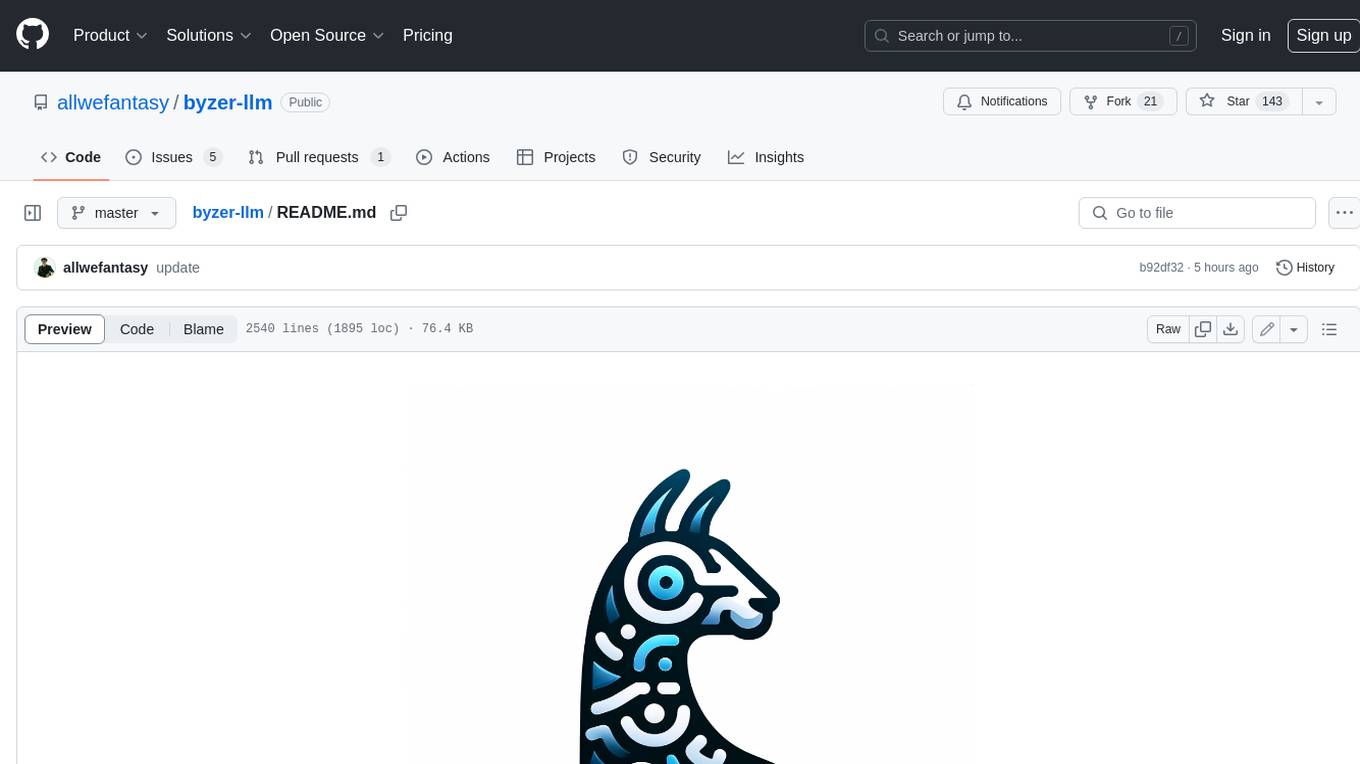
Easy, fast, and cheap pretrain, finetune, serving for everyone
README:
Latest News 🔥
- [2024/04] Release Byzer-LLM 0.1.87 ...
- [2023/12] Release Byzer-LLM 0.1.30
Byzer-LLM is Ray based , a full lifecycle solution for LLM that includes pretrain, fintune, deployment and serving.
The unique features of Byzer-LLM are:
- Full lifecyle: pretrain and finetune,deploy and serving support
- Python/SQL API support
- Ray based, easy to scale
- Versions
- Installation
- Quick Start
- How to connect Models from outside of Ray Cluster
- Embedding/Rerank
- Quatization
- Supported Models
- Serving
- LLM && Python
- Model Configurations
- SaaS Models
- Multi Modal
- StableDiffusion
- SQL Support
- Pretrain
- Finetune
- Stream Chat
- Articles
- Third-party Libraries
- Contributing
- 0.1.71: stream_chat_oai/async_chat_oai add delta_mode parameter ...
- 0.1.5: Support python wrapper for byzer-retrieval
Recommend Env:
- Conda: python==3.10.11
- OS: ubuntu 22.04
- Cuda: 12.1.0 (Optional if you only use SaaS model)
## Make sure you python version is 3.10.11
pip install -r requirements.txt
## Skip this step if you have no Nvidia GPU
pip install vllm==0.3.3
pip install -U byzerllm
ray start --headIf your cuda version is 11.8, please check the following link to install vLLM:
https://docs.vllm.ai/en/latest/getting_started/installation.html
The key steps are:
As of now, vLLM’s binaries are compiled on CUDA 12.1 by default. However, you can install vLLM with CUDA 11.8 by running:
# Install vLLM with CUDA 11.8.
export VLLM_VERSION=0.2.6
export PYTHON_VERSION=310
pip install https://github.com/vllm-project/vllm/releases/download/v${VLLM_VERSION}/vllm-${VLLM_VERSION}+cu118-cp${PYTHON_VERSION}-cp${PYTHON_VERSION}-manylinux1_x86_64.whl
# Re-install PyTorch with CUDA 11.8.
pip uninstall torch -y
pip install torch --upgrade --index-url https://download.pytorch.org/whl/cu118
# Re-install xFormers with CUDA 11.8.
pip uninstall xformers -y
pip install --upgrade xformers --index-url https://download.pytorch.org/whl/cu118Only tested on Ubuntu 20.04/22.04 CentOS 8.0
If your machine is a raw machine whithout GPU Driver and Cuda installed, you can use the following script to setup the machine:
git clone https://gitee.com/allwefantasy/byzer-llm
cd byzer-llm/setup-machineThen switch to the ROOT user, and run the following script:
ROLE=master ./setup-machine.shThis step will create a user called byzerllm.
Then switch to the byzerllm user, and run the following script:
ROLE=master ./setup-machine.shThis time the script will automatically install the following software:
- Conda
- Nvidia Driver 535
- Cuda 12.1.0
- Ray
- all the python packages in requirements.txt
- Byzer-SQL/Byzer-Notebook
If you need to add more worker nodes to the Ray cluster, repeat the above steps on the worker nodes.
Notice that the ROLE should be worker on the worker nodes.
ROLE=worker ./setup-machine.shDeploy a model:
byzerllm deploy --model_path /home/byzerllm/models/openbuddy-llama2-13b64k-v15 \
--pretrained_model_type custom/auto \
--gpu_gpus_per_worker 4 \
--num_workers 1 \
--model llama2_chat Then you can chat with the model:
byzerllm query --model llama2_chat --query "你好"You can undeploy the model like this:
byzerllm undeploy --model llama2_chatIf you need to specify the Ray address, use --ray_address.
Here is another case to show you how to deploy SaaS model:
byzerllm deploy --pretrained_model_type saas/qianwen \
--cpus_per_worker 0.01 \
--gpus_per_worker 0 \
--num_workers 1 \
--infer_params saas.api_key=xxxxx saas.model=qwen-max \
--model qianwen_short_chat import ray
from byzerllm.utils.client import ByzerLLM,LLMRequest,InferBackend
ray.init(address="auto",namespace="default",ignore_reinit_error=True)
llm = ByzerLLM()
llm.setup_gpus_per_worker(4).setup_num_workers(1)
llm.setup_infer_backend(InferBackend.transformers)
llm.deploy(model_path="/home/byzerllm/models/openbuddy-llama2-13b64k-v15",
pretrained_model_type="custom/llama2",
udf_name="llama2_chat",infer_params={})
llm_client = ByzerLLM()
llm_client.setup_template("llama2_chat","auto")
v = llm.chat_oai(model="llama2_chat",conversations=[{
"role":"user",
"content":"hello",
}])
print(v[0].output)The above code will deploy a llama2 model and then use the model to infer the input text. If you use transformers as the inference backend, you should specify the pretrained_model_type manually since the transformers backend can not auto detect the model type.
Byzer-LLM also support deploy SaaS model with the same way. This feature provide a unified interface for both open-source model and SaaS model. The following code will deploy a Azure OpenAI model and then use the model to infer the input text.
import ray
from byzerllm.utils.client import ByzerLLM,LLMRequest,InferBackend
ray.init(address="auto",namespace="default",ignore_reinit_error=True)
llm = ByzerLLM()
llm.setup_gpus_per_worker(0).setup_num_workers(10)
llm.setup_infer_backend(InferBackend.transformers)
llm.deploy(pretrained_model_type="saas/azure_openai",
udf_name="azure_openai",
infer_params={
"saas.api_type":"azure",
"saas.api_key"="xxx"
"saas.api_base"="xxx"
"saas.api_version"="2023-07-01-preview"
"saas.deployment_id"="xxxxxx"
})
llm_client = ByzerLLM()
llm_client.setup_template("azure_openai","auto")
v = llm.chat_oai(model="azure_openai",conversations=[{
"role":"user",
"content":"hello",
}])
print(v[0].output)Notice that the SaaS model does not need GPU, so we set the setup_gpus_per_worker to 0, and you can use setup_num_workers
to control max concurrency,how ever, the SaaS model has its own max concurrency limit, the setup_num_workers only control the max
concurrency accepted by the Byzer-LLM.
The recommended way is to start a empty Ray worker in your target machine(e.g. Your web server machine):
ray start --address="xxxxx:6379" --num-gpus=0 --num-cpus=0 Then you can connect the Models from outside of the Ray cluster:
import ray
from byzerllm.utils.client import ByzerLLM,LLMRequest,InferBackend
## connect the ray cluster by the empty worker we started before
## this code should be run once in your prorgram
ray.init(address="auto",namespace="default",ignore_reinit_error=True)
## new a ByzerLLM instance
llm_client = ByzerLLM()
llm_client.setup_template("llama2_chat","auto")
v = llm.chat_oai(model="llama2_chat",conversations=[{
"role":"user",
"content":"hello",
}])
print(v[0].output)Or
from dataclasses import asdict
import json
import base64
import byzerllm
from byzerllm.utils.client.types import Templates
byzerllm.connect_cluster(address="ray://CLUSTER_IP:10001")
model_name = "zephyr_7b_chat"
llm = byzerllm.ByzerLLM()
llm.setup_template(model=model_name,template=Templates.default())
llm.setup_default_model_name(model_name)
t = llm.chat_oai(conversations=[{
"role":"user",
"content":"你好"}])
print(t[0].output)The following code is a example of deploying BGE embedding model
import ray
from byzerllm.utils.client import ByzerLLM,LLMRequest,InferBackend
ray.init(address="auto",namespace="default",ignore_reinit_error=True)
llm = ByzerLLM()
llm.setup_gpus_per_worker(0.4).setup_num_workers(2).setup_infer_backend(InferBackend.Transformers)
llm.deploy(
model_path="/home/byzerllm/models/bge-large-zh",
pretrained_model_type="custom/bge",
udf_name="emb",
infer_params={}
) Then you can convert any text to vector :
t = llm.emb("emb",LLMRequest(instruction="wow"))
t[0].output
#output: [-0.005588463973253965,
-0.01747054047882557,
-0.040633779019117355,
...
-0.010880181565880775,
-0.01713103987276554,
0.017675869166851044,
-0.010260719805955887,
...]The Byzer-LLM also support SaaS embedding model. The following code will deploy a Baichuan embedding model and then use the model to infer the input text.
import os
os.environ["RAY_DEDUP_LOGS"] = "0"
import ray
from byzerllm.utils.retrieval import ByzerRetrieval
from byzerllm.utils.client import ByzerLLM,LLMRequest,LLMResponse,LLMHistoryItem,InferBackend
from byzerllm.utils.client import Templates
ray.init(address="auto",namespace="default",ignore_reinit_error=True)
llm = ByzerLLM(verbose=True)
llm.setup_num_workers(1).setup_gpus_per_worker(0)
chat_name = "baichuan_emb"
if llm.is_model_exist(chat_name):
llm.undeploy(udf_name=chat_name)
llm.deploy(model_path="",
pretrained_model_type="saas/baichuan",
udf_name=chat_name,
infer_params={
"saas.api_key":"",
"saas.model":"Baichuan-Text-Embedding"
})
llm.setup_default_emb_model_name(chat_name)
v = llm.emb(None,LLMRequest(instruction="你好"))
print(v.output)If you need to use embedding rerank model, you can refer to the following usage.
import ray
from byzerllm.utils.client import ByzerLLM,LLMRequest,InferBackend
ray.init(address="auto",namespace="default",ignore_reinit_error=True)
llm = ByzerLLM()
llm.setup_gpus_per_worker(0.4).setup_num_workers(2).setup_infer_backend(InferBackend.Transformers)
llm.deploy(
model_path="/Users/wanghan/data/bge-reranker-base",
pretrained_model_type="custom/bge_rerank",
udf_name="emb_rerank",
infer_params={}
)
llm.setup_default_emb_model_name("emb_rerank")Then you can get a relevance score by inputting query and passage to the reranker
sentence_pairs_01 = ['query', 'passage']
t1 = llm.emb_rerank(sentence_pairs=sentence_pairs_01)
print(t1[0].output)
#output [['query', 'passage'], 0.4474925994873047]
sentence_pairs_02 = [['what is panda?', 'hi'], ['what is panda?','The giant panda (Ailuropoda melanoleuca), sometimes called a panda bear or simply panda, is a bear species endemic to China.']]
t2 = llm.emb_rerank(sentence_pairs=sentence_pairs_02)
print(t2[0].output)
#output [[['what is panda?', 'The giant panda (Ailuropoda melanoleuca), sometimes called a panda bear or simply panda, is a bear species endemic to China.'], 6.1821160316467285], [['what is panda?', 'hi'], -8.154398918151855]]If the backend is InferBackend.transformers, here is the baichuan2 example:
llm.setup_gpus_per_worker(2).setup_num_workers(1).setup_infer_backend(InferBackend.Transformers)
llm.deploy(
model_path=model_location,
pretrained_model_type="custom/baichuan2",
udf_name="baichuan2_13_chat",
infer_params={"quatization":"4"}
)The available quatization values:
- 4
- 8
- true/false
When it's set true, the int4 will be choosed.
If the bakcend is InferBackend.VLLM, here is the Yi example:
If you need to deploy model with Quantization, you can set the infer_params as the following code:
llm.setup_gpus_per_worker(1).setup_num_workers(1).setup_infer_backend(InferBackend.VLLM)
llm.deploy(
model_path="/home/winubuntu/models/Yi-6B-Chat-4bits",
pretrained_model_type="custom/auto",
udf_name="chat",
infer_params={"backend.quantization":"AWQ"}
)The parameter backend.quantization can be GPTQ/AWQ.
The supported open-source pretrained_model_type are:
- custom/llama2
- bark
- whisper
- chatglm6b
- custom/chatglm2
- moss
- custom/alpha_moss
- dolly
- falcon
- llama
- custom/starcode
- custom/visualglm
- custom/m3e
- custom/baichuan
- custom/bge
- custom/qwen_vl_chat
- custom/stable_diffusion
- custom/zephyr
The supported SaaS pretrained_model_type are:
- saas/chatglm Chatglm130B
- saas/sparkdesk 星火大模型
- saas/baichuan 百川大模型
- saas/zhipu 智谱大模型
- saas/minimax MiniMax 大模型
- saas/qianfan 文心一言
- saas/azure_openai
- saas/openai
Notice that the derived models from llama/llama2/startcode are also supported. For example, you can use llama to load vicuna model.
The Byzer-llm also support vLLM as the inference backend. The following code will deploy a vLLM model and then use the model to infer the input text.
import ray
from byzerllm.utils.retrieval import ByzerRetrieval
from byzerllm.utils.client import ByzerLLM,LLMRequest,InferBackend
ray.init(address="auto",namespace="default",ignore_reinit_error=True)
llm = ByzerLLM()
llm.setup_gpus_per_worker(2)
llm.setup_num_workers(1)
llm.setup_infer_backend(InferBackend.VLLM)
llm.deploy(
model_path="/home/byzerllm/models/openbuddy-zephyr-7b-v14.1",
pretrained_model_type="custom/auto",
udf_name="zephyr_chat"",
infer_params={}
)
v = llm.chat_oai(model="zephyr_chat",conversations=[{
"role":"user",
"content":"hello",
}])
print(v[0].output)There are some tiny differences between the vLLM and the transformers backend.
- The
pretrained_model_typeis fixed tocustom/autofor vLLM, since the vLLM will auto detect the model type. - Use
setup_infer_backendto specifyInferBackend.VLLMas the inference backend.
If you use the version of vLLM > 0.2.7 and meets the following error:
Error Type: TASK_EXECUTION_EXCEPTION
self._call_impl(*args, **kwargs)
File "/home/byzerllm/miniconda3/envs/byzerllm-dev2/lib/python3.10/site-packages/torch/nn/modules/module.py", line 1527, in _call_impl
return forward_call(*args, **kwargs)
File "/home/byzerllm/miniconda3/envs/byzerllm-dev2/lib/python3.10/site-packages/vllm/model_executor/layers/vocab_parallel_embedding.py", line 96, in forward
input_mask = ((input_ < self.vocab_start_index) |
TypeError: '<' not supported between instances of 'TensorMetadata' and 'int'You can open the Ray dashboard and find the RayVLLMWorker Actor, go into and check the tasks tab and click the error task to get the error message above.
The solution is to modify the $CONDA_ENV/site-packages/vllm/model_executor/parallel_utils/communication_op.py in the vLLM pip package:
Replace the following code:
TensorMetadata = namedtuple("TensorMetadata", ["dtype", "size"])to
class TensorMetadata:
def __init__(self, dtype, size):
self.dtype = dtype
self.size = sizeIf the model deployed with the backend vLLM, then it also support stream chat:
the stream_chat_oai will return a generator, you can use the generator to get the output text.
llm.setup_default_model_name(chat_model_name)
t = llm.stream_chat_oai(conversations=[{
"role":"user",
"content":"Hello, how are you?"
}])
for line in t:
print(line+"\n")The Byzer-llm also support DeepSpeed as the inference backend. The following code will deploy a DeepSpeed model and then use the model to infer the input text.
import ray
from byzerllm.utils.retrieval import ByzerRetrieval
from byzerllm.utils.client import ByzerLLM,LLMRequest,InferBackend
ray.init(address="auto",namespace="default",ignore_reinit_error=True)
llm = ByzerLLM()
llm.setup_gpus_per_worker(4)
llm.setup_num_workers(1)
llm.setup_infer_backend(InferBackend.DeepSpeed)
llm.deploy(
model_path="/home/byzerllm/models/openbuddy-llama-13b-v5-fp16",
pretrained_model_type="custom/auto",
udf_name="llama_chat"",
infer_params={}
)
llm.chat("llama_chat",LLMRequest(instruction="hello world"))[0].outputThe code above is totally the same as the code for vLLM, except that the InferBackend is InferBackend.DeepSpeed.
byzerllm deploy --pretrained_model_type custom/auto \
--infer_backend llama_cpp \
--cpus_per_worker 0.001 \
--gpus_per_worker 0 \
--num_workers 1 \
--worker_concurrency 10 \
--infer_params verbose=true \
--model_path /Users/allwefantasy/Downloads/Meta-Llama-3-8B-Instruct-Q4_K_M.gguf \
--model llama_3_chatYou can set
-
num_gpu_layers=-1in--infer_params - gpu_gpus_per_worker=x
to put all model to the GPU or num_gpu_layers=0 and gpu_gpus_per_worker=0 to disable it.
The num_gpu_layers also accept a positive number to specify the number of layers to use GPU.
You can use the following code to start a ByzerLLm OpenAI-Compatible RESTful API server:
byzerllm serve --ray_address auto --port 8000By default, the server will listen on port 8000, you can use the following code to test the API:
from openai import OpenAI
client = OpenAI(
base_url="http://127.0.0.1:8000/v1",
api_key="xxxx"
)
chat_completion = client.chat.completions.create(
model="wenxin_chat",
messages=[{"role": "user", "content": "写一个排序算法"}],
stream=False
)
print(chat_completion.choices[0].message.content)Stream chat:
from openai import OpenAI
client = OpenAI(
base_url="http://127.0.0.1:8000/v1",
api_key="simple"
)
chat_completion = client.chat.completions.create(
model="wenxin_chat",
messages=[{"role": "user", "content": "写一个排序算法"}],
stream=True
)
for chunk in chat_completion:
print(chunk.choices[0].delta.content or "", end="")Here is a simple example for function calling based on QWen 72B
Deploy Model:
import ray
ray.init(address="auto",namespace="default")
llm = ByzerLLM()
model_location="/home/byzerllm/models/Qwen-72B-Chat"
llm.setup_gpus_per_worker(8).setup_num_workers(1).setup_infer_backend(InferBackend.VLLM)
llm.deploy(
model_path=model_location,
pretrained_model_type="custom/auto",
udf_name=chat_model_name,
infer_params={}
)
llm.setup_default_model_name("chat")
# from 0.1.24
# llm.setup_auto("chat")
meta = llm.get_meta()
llm.setup_max_model_length("chat",meta.get("max_model_len",32000))
lm.setup_template("chat",Templates.qwen()) Try to create some Python functions:
from typing import List,Dict,Any,Annotated
import pydantic
import datetime
from dateutil.relativedelta import relativedelta
def compute_date_range(count:Annotated[int,"时间跨度,数值类型"],
unit:Annotated[str,"时间单位,字符串类型",{"enum":["day","week","month","year"]}])->List[str]:
'''
计算日期范围
Args:
count: 时间跨度,数值类型
unit: 时间单位,字符串类型,可选值为 day,week,month,year
'''
now = datetime.datetime.now()
now_str = now.strftime("%Y-%m-%d %H:%M:%S")
if unit == "day":
return [(now - relativedelta(days=count)).strftime("%Y-%m-%d %H:%M:%S"),now_str]
elif unit == "week":
return [(now - relativedelta(weeks=count)).strftime("%Y-%m-%d %H:%M:%S"),now_str]
elif unit == "month":
return [(now - relativedelta(months=count)).strftime("%Y-%m-%d %H:%M:%S"),now_str]
elif unit == "year":
return [(now - relativedelta(years=count)).strftime("%Y-%m-%d %H:%M:%S"),now_str]
return ["",""]
def compute_now()->str:
'''
计算当前时间
'''
return datetime.datetime.now().strftime("%Y-%m-%d %H:%M:%S")Here we provide two functions:
- compute_date_range: compute the date range based on the count and unit
- compute_now: get the current date
We will use the model to call these tools according to the user's question.
t = llm.chat_oai([{
"content":'''计算当前时间''',
"role":"user"
}],tools=[compute_date_range,compute_now],execute_tool=True)
t[0].values
## output: ['2023-12-18 17:30:49']t = llm.chat_oai([{
"content":'''最近三个月趋势''',
"role":"user"
}],tools=[compute_date_range,compute_now],execute_tool=True)
t[0].values
## output: [['2023-09-18 17:31:21', '2023-12-18 17:31:21']]t = llm.chat_oai([{
"content":'''最近三天''',
"role":"user"
}],tools=[compute_date_range,compute_now],execute_tool=True)
t[0].values
## output: [['2023-12-15 17:23:38', '2023-12-18 17:23:38']]t = llm.chat_oai([{
"content":'''你吃饭了么?''',
"role":"user"
}],tools=[compute_date_range,compute_now],execute_tool=True)
if t[0].values:
print(t[0].values[0])
else:
print(t[0].response.output)
## output: '您好,我是一个人工智能语言模型,暂时无法吃饭。'You can check the default prompt template function in from byzerllm.utils import function_calling_format.
If the model is not work well with the default function, you can setup your custom function:
def custom_function_calling_format(prompt:str,tools:List[Callable],tool_choice:Callable)->str:
.....
llm.setup_function_calling_format_func("chat",custom_function_calling_format)When you chat with LLM, you can specify the reponse class,
import pydantic
class Story(pydantic.BaseModel):
'''
故事
'''
title: str = pydantic.Field(description="故事的标题")
body: str = pydantic.Field(description="故事主体")
t = llm.chat_oai([
{
"content":f'''请给我讲个故事,分成两个部分,一个标题,一个故事主体''',
"role":"user"
},
],response_class=Story)
t[0].value
## output: Story(title='勇敢的小兔子', body='在一个美丽的森林里,住着一只可爱的小兔子。小兔子非常勇敢,有一天,森林里的动物们都被大灰狼吓坏了。只有小兔子站出来,用智慧和勇气打败了大灰狼,保护了所有的动物。从此,小兔子成为了森林里的英雄。')The above code will ask the LLM to generate the Story class directly. However, sometimes we hope the LLM
generate text first, then extract the structure from the text, you can set response_after_chat=True to
enable this behavior. However, this will bring some performance penalty(additional inference).
t = llm.chat_oai([
{
"content":f'''请给我讲个故事,分成两个部分,一个标题,一个故事主体''',
"role":"user"
},
],response_class=Story,response_after_chat=True)
t[0].value
## output: Story(title='月光下的守护者', body='在一个遥远的古老村庄里,住着一位名叫阿明的年轻人。阿明是个孤儿,从小在村里长大,以种田为生。他善良、勤劳,深受村民们喜爱。\n\n村子里有个传说,每当满月时分,月亮女神会在村子后山的古树下出现,赐福给那些善良的人们。然而,只有最纯洁的心才能看到她。因此,每年的这个时候,阿明都会独自一人前往后山,希望能得到女神的祝福。\n\n这一年,村子遭受了严重的旱灾,庄稼枯黄,人们生活困苦。阿明决定向月亮女神祈求降雨,拯救村子。他在月光下虔诚地祈祷,希望女神能听到他的呼唤。\n\n就在这个时刻,月亮女神出现了。她被阿明的善良和执着所感动,答应了他的请求。第二天早晨,天空乌云密布,大雨倾盆而下,久旱的土地得到了滋润,庄稼重新焕发生机。\n\n从此以后,每年的满月之夜,阿明都会去后山等待月亮女神的出现,他成为了村民心中的守护者,用他的善良和执着,守护着整个村庄。而他也终于明白,真正的守护者,并非需要超凡的力量,只需要一颗充满爱与善良的心。')You can check the default prompt template function in from byzerllm.utils import response_class_format,response_class_format_after_chat.
If the model is not work well with the default function, you can setup your custom function:
def custom_response_class_format(prompt:str,cls:pydantic.BaseModel)->str:
.....
llm.setup_response_class_format_func("chat",custom_response_class_format)The Byzer-llm also support function implementation. You can define a empty function, and combine the doc in the function/the user's quesion to guide the LLM to implement the function.
Here is a simple example:
from byzerllm.utils.client import code_utils,message_utils
from typing import List,Union,Optional
import pydantic
class Time(pydantic.BaseModel):
time: str = pydantic.Field(...,description="时间,时间格式为 yyyy-MM-dd")
@llm.impl()
def calculate_current_time()->Time:
'''
计算当前时间
'''
pass
calculate_current_time()
#output: Time(time='2024-01-28')By default, the function implementation will be cached,
start = time.monotonic()
calculate_current_time()
print(f"first time cost: {time.monotonic()-start}")
start = time.monotonic()
calculate_current_time()
print(f"second time cost: {time.monotonic()-start}")
# output:
# first time cost: 6.067266260739416
# second time cost: 4.347506910562515e-05you can use llm.clear_impl_cache() to clear the cache.
Here is the example for function implementation with parameters:
from byzerllm.utils.client import code_utils,message_utils
from typing import List,Union,Optional,Annotated
import pydantic
from datetime import datetime
class Time(pydantic.BaseModel):
time: str = pydantic.Field(...,description="时间,时间格式为 yyyy-MM-dd")
@llm.impl()
def add_one_day(current_day:Annotated[datetime,"当前日期,类型是datatime.datetime"])->Time:
'''
给传入的日期加一天,得到明天的时间
'''
pass
add_one_day(datetime.now())
# output:Time(time='2024-01-29')With instruction:
from byzerllm.utils.client import code_utils,message_utils
from typing import List,Union,Optional
import pydantic
class TimeRange(pydantic.BaseModel):
'''
时间区间
格式需要如下: yyyy-MM-dd
'''
start: str = pydantic.Field(...,description="开始时间.时间格式为 yyyy-MM-dd")
end: str = pydantic.Field(...,description="截止时间.时间格式为 yyyy-MM-dd")
@llm.impl(instruction="去年三月到七月")
def calculate_time_range()->TimeRange:
'''
计算时间区间,时间格式为 yyyy-MM-dd.
'''
pass
calculate_time_range()
# output: TimeRange(start='2023-03-01', end='2023-07-31')If you want to replace instruction with the user's question, you can use the following code:
from byzerllm.utils.client import code_utils,message_utils
from typing import List,Union,Optional
import pydantic
class TimeRange(pydantic.BaseModel):
'''
时间区间
格式需要如下: yyyy-MM-dd
'''
start: str = pydantic.Field(...,description="开始时间.时间格式为 yyyy-MM-dd")
end: str = pydantic.Field(...,description="截止时间.时间格式为 yyyy-MM-dd")
def calculate_time_range()->TimeRange:
'''
计算时间区间,时间格式为 yyyy-MM-dd.
'''
pass
llm.impl(instruction="去年三月到七月")(calculate_time_range)()You can use verbose=True to get more information about the function implementation:
@llm.impl()
def add_one_day(current_day:Annotated[datetime,"当前日期,类型是datatime.datetime"])->Time:
'''
给传入的日期加一天,得到明天的时间
'''
pass You can also use the basic chat_oai function to implement the function:
class TimeRange(pydantic.BaseModel):
'''
时间区间
格式需要如下: yyyy-MM-dd
'''
start: str = pydantic.Field(...,description="开始时间.时间格式为 yyyy-MM-dd")
end: str = pydantic.Field(...,description="截止时间.时间格式为 yyyy-MM-dd")
def calculate_time_range():
'''
计算时间区间,时间格式为 yyyy-MM-dd.
'''
pass
t = llm.chat_oai([{
"content":"去年三月到七月",
"role":"user"
}],impl_func=calculate_time_range,response_class=TimeRange,execute_impl_func=True)The above code , we define a function called calculate_time_range, and the function is empty, then we discribe the function in the doc string, and define the response class TimeRange, to make sure the return value is a TimeRange instance. Since the function should be used to resolve the user's question, so the implementation of the function should be related to the user's question. Instead try to implement a common use function, we can just implement a function which can only resolve the user's current question.
After the execution, you can get the output like this:
t[0].value
# start='2023-03-01' end='2023-07-31'If the value is None or not correct, you can get the error message:
t[0].metadata.get("resason","")If your function has parameters, you can pass the parameters to the function by impl_func_params:
t = llm.chat_oai([{
"content":"xxxxx",
"role":"user"
}],
impl_func=calculate_time_range,
impl_func_params={},
response_class=TimeRange,execute_impl_func=True)If you want to replace the default prompt template function, here is a example:
import pydantic
from typing import List,Optional,Union,Callable
from byzerllm.utils import serialize_function_to_json
def function_impl_format2(prompt:str,func:Optional[Union[Callable,str]],
cls:Union[pydantic.BaseModel,str])->str:
tool_choice_ser = serialize_function_to_json(func)
_cls = ""
if isinstance(cls, str):
_cls = cls
else:
_cls = cls.schema_json(ensure_ascii=False)
msg = f''''生成一个python函数,给出详细的思考逻辑,对最后生成的函数不要进行示例说明。
生成的函数的名字以及参数需要满足如下约束:
\```json
{tool_choice_ser}
\```
生成的函数的返回值必须是 Json 格式。
下面是使用 OpenAPI 3.1. 规范描述了你需如何进行json格式的生成。
\```json
{_cls}
\```
根据用的户问题,{func.__doc__}。用户的问题是:{prompt}
请你实现这个函数。
'''
return msg
llm.setup_impl_func_format_func(chat_model_name,function_impl_format2)The default prompt template function is function_impl_format, you can check the source code in from byzerllm.utils import function_impl_format.
If you want to improve the performance of Function Calling or Response Class, you should make your Function(Tool) and Data Class is LLM-Friendly.
Let's take a look at the following python code:
def compute_date_range(count:int, unit:str)->List[str]:
now = datetime.datetime.now()
....This code is not LLM-Friendly Function since it's difficult to know the usage of this funciton and what's the meaning of the input parameters.
The LLM just like human, it's hard to let the LLM know when or how to invoke this function. Especially the parameter unit
actually is enum value but the LLM no way to get this message.
So, in order to make the LLM knows more about this function in Byzer-LLM, you should follow some requirments:
- Adding pythonic function comment
- Use annotated to provide type and comment for every parameter, if the parameter is a enum, then provide enum values.
Here is the LLM-Friendly fuction definision.
def compute_date_range(count:Annotated[int,"时间跨度,数值类型"],
unit:Annotated[str,"时间单位,字符串类型",{"enum":["day","week","month","year"]}])->List[str]:
'''
计算日期范围
Args:
count: 时间跨度,数值类型
unit: 时间单位,字符串类型,可选值为 day,week,month,year
'''
now = datetime.datetime.now()
....If the LLM make something wrong to your function (e.g. provide the bad parameters), try to optimize the function comment and the parameter Annotated comment.
The Byzer-llm also support get the model meta information. The following code will get the meta information of model instance called chat:
```python
llm.get_meta(model="chat")
#output:
# {'model_deploy_type': 'proprietary',
# 'backend': 'ray/vllm',
# 'max_model_len': 32768,
# 'architectures': ['QWenLMHeadModel']}The different models have different chat templates, the Byzer-LLM have provide some chat templates for the models. You can use the following code to setup the chat template:
from byzerllm.utils.client import Templates
llm.setup_template("chat",Templates.qwen()) However, we also support the tokeninzer.apply_chat_template, you can use the following code to apply the chat template:
llm.setup_template("chat","auto") If the model is not work well with the tokeninzer.apply_chat_template, this function will raise an exception. In this case, you can use the llm.setup_template to setup the chat template manually.
You can also use the llm.get_meta to check if the model support the apply_chat_template:
llm.get_meta(model="chat")The output:
{'model_deploy_type': 'proprietary',
'backend': 'ray/vllm',
'support_stream': True,
'support_chat_template': True,
'max_model_len': 4096,
'architectures': ['LlamaForCausalLM']}Notice that this feature will cause additional RPC call, so it will bring some performance penalty.
Prompt Function is a function implemented by text instead of code. The Prompt function will auto bind the function parameters to the function's doc string.
Prompt Class is a class which contains the prompt function.
Here is a simple example for prompt function:
@llm.prompt(render="simple")
def generate_answer(context:str,question:str)->str:
'''
Answer the question based on only the following context:
{context}
Question: {question}
Answer:
'''
pass
context='''
Byzer产品栈从底层存储到大模型管理和serving再到应用开发框架:
1. Byzer-Retrieval, 一个支持向量+搜索的混合检索数据库。
2. Byzer-LLM, 可以衔接SaaS/开源模型,能部署,可以统一入口。
3. Byzer-Agent ,一套分布式 Agent 框架,做为应用开发框架
4. ByzerPerf, 一套性能吞吐评测框架
5. ByzerEvaluation, 一套大模型效果评测框架 (未开源)
6. Byzer-SQL, 一套全SQL方言,支持ETL,数据分析等工作,并且支持大模型的管理和调用(model as UDF),方便数据预处理。
'''
print(generate_answer(context=context,question="Byzer SQL是什么?"))
## output: Byzer SQL 是一个全SQL方言,支持ETL、数据分析等工作,并且支持大模型的管理和调用(model as UDF),方便数据预处理。Now we try to convert the prompt function to prompt class:
import ray
from byzerllm.utils.client import ByzerLLM
import byzerllm
ray.init(address="auto",namespace="default",ignore_reinit_error=True)
class RAG():
def __init__(self):
self.llm = ByzerLLM()
self.llm.setup_template(model="sparkdesk_chat",template="auto")
self.llm.setup_default_model_name("sparkdesk_chat")
@byzerllm.prompt(lambda self: self.llm,render="simple")
def generate_answer(self,context:str,question:str)->str:
'''
Answer the question based on only the following context:
{context}
Question: {question}
Answer:
'''
pass
t = RAG()
print(t.generate_answer(context=context,question="Byzer SQL是什么?")) The first parameter of the byzerllm.prompt is the llm instance, the following type can be accepted:
- lambda function: the lambda function will accept the
selfas the parameter, and then you can access the llm instance by self - string: the string is the model name, we will create the llm instance by the model name automatically.
- llm: the llm instance.
Notice that the llm instance we mentioned above is the ByzerLLM instance.
If you only want to get the prompt which is bind the parameters instead of execute the prompt, you can use the following code:
import ray
from byzerllm.utils.client import ByzerLLM
import byzerllm
ray.init(address="auto",namespace="default",ignore_reinit_error=True)
class RAG():
def __init__(self):
self.llm = ByzerLLM()
self.llm.setup_template(model="sparkdesk_chat",template="auto")
self.llm.setup_default_model_name("sparkdesk_chat")
@byzerllm.prompt(render="simple")
def generate_answer(self,context:str,question:str)->str:
'''
Answer the question based on only the following context:
{context}
Question: {question}
Answer:
'''
pass
t = RAG()
print(t.generate_answer(context=context,question="Byzer SQL是什么?"))The difference between the two code is that the byzerllm.prompt whether have delived the llm` instance to the prompt function.
Here is the output:
Answer the question based on only the following context:
Byzer产品栈从底层存储到大模型管理和serving再到应用开发框架:
1. Byzer-Retrieval, 一个支持向量+搜索的混合检索数据库。
2. Byzer-LLM, 可以衔接SaaS/开源模型,能部署,可以统一入口。
3. Byzer-Agent ,一套分布式 Agent 框架,做为应用开发框架
4. ByzerPerf, 一套性能吞吐评测框架
5. ByzerEvaluation, 一套大模型效果评测框架 (未开源)
6. Byzer-SQL, 一套全SQL方言,支持ETL,数据分析等工作,并且支持大模型的管理和调用(model as UDF),方便数据预处理。
Question: Byzer SQL是什么?
Answer:
Prompt function support two kinds of return value:
- str
- pydanitc.BaseModel
Here is the example for pydanitc.BaseModel:
import ray
import functools
import inspect
import byzerllm
import pydantic
ray.init(address="auto",namespace="default",ignore_reinit_error=True)
class ByzerProductDesc(pydantic.BaseModel):
byzer_retrieval: str
byzer_llm: str
byzer_agent: str
byzer_perf: str
byzer_evaluation: str
byzer_sql: str
class RAG():
def __init__(self):
self.llm = ByzerLLM()
self.llm.setup_template(model="sparkdesk_chat",template="auto")
self.llm.setup_default_model_name("sparkdesk_chat")
@byzerllm.prompt(lambda self: self.llm,render="simple")
def generate_answer(self,context:str,question:str)->ByzerProductDesc:
'''
Answer the question based on only the following context:
{context}
Question: {question}
Answer:
'''
pass
t = RAG()
byzer_product = t.generate_answer(context=context,question="Byzer 产品列表")
print(byzer_product.byzer_sql)
## output: 一套全SQL方言,支持ETL,数据分析等工作,并且支持大模型的As we know, the prompt function is a function implemented by text instead of code, the lucky thing is that we can program
in the text, we introduce the jinjia2 to support this feature. Here is the example:
import ray
import functools
import inspect
import byzerllm
import pydantic
from byzerllm.utils.client import ByzerLLM
ray.init(address="auto",namespace="default",ignore_reinit_error=True)
data = {
'name': 'Jane Doe',
'task_count': 3,
'tasks': [
{'name': 'Submit report', 'due_date': '2024-03-10'},
{'name': 'Finish project', 'due_date': '2024-03-15'},
{'name': 'Reply to emails', 'due_date': '2024-03-08'}
]
}
class RAG():
def __init__(self):
self.llm = ByzerLLM()
self.llm.setup_template(model="sparkdesk_chat",template="auto")
self.llm.setup_default_model_name("sparkdesk_chat")
@byzerllm.prompt(lambda self:self.llm,render="jinja2")
def generate_answer(self,name,task_count,tasks)->str:
'''
Hello {{ name }},
This is a reminder that you have {{ task_count }} pending tasks:
{% for task in tasks %}
- Task: {{ task.name }} | Due: {{ task.due_date }}
{% endfor %}
Best regards,
Your Reminder System
'''
pass
t = RAG()
response = t.generate_answer(**data)
print(response)
## output:Hello! Is there anything else I can assist you with?If you want to handle the parameters in the prompt function using Python code instead of Jinjia2, you can use the following code:
import byzerllm
byzerllm.connect_cluster()
data = {
'name': 'Jane Doe',
'task_count': 3,
'tasks': [
{'name': 'Submit report', 'due_date': '2024-03-10'},
{'name': 'Finish project', 'due_date': '2024-03-15'},
{'name': 'Reply to emails', 'due_date': '2024-03-08'}
]
}
class RAG():
def __init__(self):
self.llm = byzerllm.ByzerLLM()
self.llm.setup_template(model="sparkdesk_chat",template="auto")
self.llm.setup_default_model_name("sparkdesk_chat")
@byzerllm.prompt(lambda self:self.llm,render="jinja2")
def generate_answer(self,name,task_count,tasks)->str:
'''
Hello {{ name }},
This is a reminder that you have {{ task_count }} pending tasks:
{{ tasks }}
Best regards,
Your Reminder System
'''
tasks_str = "\n".join([f"- Task: {task['name']} | Due: { task['due_date'] }" for task in tasks])
return {"tasks": tasks_str}
t = RAG()
response = t.generate_answer(**data)
print(response)Make sure the return value is a dict, and the key is the parameter name in the prompt function. The return value will override the parameter value and then use the new value to render the prompt function.
The Byzer-llm also support setup the default generation parameters for the model. The following code will setup the default generation parameters for the model instance called chat:
llm.setup_extra_generation_params("chat",{
"generation.stop_token_ids":[7]
})In this case, the generation.stop_token_ids will be set to [7] for the model instance chat. Every time you call the chat model, the generation.stop_token_ids will be set to [7] automatically.
Byzer-LLM have multi-type requests to the model instance.
- embedding
- tokenizer
- apply_chat_template
- meta
- complete/chat
And in Byzer-LLM you can start one model instance which have multi workers,e.g.
llm.setup_gpus_per_worker(2).setup_num_workers(4).setup_infer_backend(InferBackend.VLLM)
llm.deploy(
model_path=model_location,
pretrained_model_type="custom/auto",
udf_name="chat",
infer_params={"backend.gpu_memory_utilization":0.8,
"backend.enforce_eager":False,
"backend.trust_remote_code":True,
"backend.max_model_len":1024*4,
"backend.quantization":"gptq",
}
)Here you deploy one model instance with 4 workers, and each worker have 2 gpus, each worker is a vLLM instance. The ByzerLLM will auto route the request to the worker, and the worker is selected by the LRU algorithm.
If you want to the request like embedding,tokenizer,apply_chat_template,meta to be processed by the same worker, you can use the following code:
llm.setup_pin_model_worker_mapping({
"embedding":0,
"tokenizer":0,
"apply_chat_template":0,
"meta":0,
} this will make sure the request like embedding,tokenizer,apply_chat_template,meta to be processed by the worker 0.
In Byzer-LLM you can start one model instance which have multi workers,e.g.
llm.setup_gpus_per_worker(2).setup_num_workers(4).setup_infer_backend(InferBackend.VLLM)
llm.deploy(
model_path=model_location,
pretrained_model_type="custom/auto",
udf_name="chat",
infer_params={"backend.gpu_memory_utilization":0.8,
"backend.enforce_eager":False,
"backend.trust_remote_code":True,
"backend.max_model_len":1024*4,
"backend.quantization":"gptq",
}
)Here you deploy one model instance with 4 workers, each worker have 2 gpus, and each worker is a vLLM instance. By default, the ByzerLLM will auto route the request to the worker, and the worker is selected by the LRU algorithm. You can change this behavior by using the following code:
llm.setup_gpus_per_worker(8).setup_num_workers(1).setup_infer_backend(InferBackend.VLLM)
llm.setup_worker_concurrency(999)
llm.setup_load_balance_way("round_robin")
llm.deploy(
model_path=model_location,
pretrained_model_type="custom/auto",
udf_name=chat_model_name,
infer_params={"backend.gpu_memory_utilization":0.8,
"backend.enforce_eager":False,
"backend.trust_remote_code":True,
"backend.max_model_len":1024*4,
"backend.quantization":"gptq",
}
)Here you can use the setup_worker_concurrency to setup the worker concurrency, and use the setup_load_balance_way to setup the load balance way. For now, the Byzer-LLM support the following load balance way:
- round_robin
- lru
The Byzer-llm also support multi modal. The following code will deploy a multi modal model and then use the model to infer the input text.
import ray
from byzerllm.utils.client import ByzerLLM,InferBackend
ray.init(address="auto",namespace="default")
llm = ByzerLLM()
chat_model_name = "qwen_vl_chat"
model_location = "/home/byzerllm/models/Qwen-VL-Chat"
llm.setup_gpus_per_worker(1).setup_num_workers(1).setup_infer_backend(InferBackend.Transformers)
llm.deploy(
model_path=model_location,
pretrained_model_type="custom/qwen_vl_chat",
udf_name=chat_model_name,
infer_params={}
) Then you can use the model to chat:
import base64
image_path = "/home/byzerllm/projects/jupyter-workspace/1.jpg"
with open(image_path, "rb") as f:
image_content = base64.b64encode(f.read()).decode("utf-8")
t = llm.chat_oai(conversations=[{
"role": "user",
"content": "这是什么"
}],model=chat_model_name,llm_config={"image":image_content})
t[0].output
# '{"response": "图中是一名女子在沙滩上和狗玩耍,旁边的狗是一只拉布拉多犬,它坐在沙滩上,面对着一名身穿格子衬衫的女子。女子的腿有些残疾,但是她依然坚持坐在沙滩上和狗玩耍。她的右手拿着一个小玩具,这个玩具上面有两行黑色字母,具体是什么内容看不清楚。她打算把玩具扔给拉布拉多犬。", "history": [{"role": "user", "content": "Picture 1: <img>/tmp/byzerllm/visualglm/images/23eb4cea-cb6e-4f55-8adf-3179ca92ab42.jpg</img>\\n这是什么"}, {"role": "assistant", "content": "图中是一名女子在沙滩上和狗玩耍,旁边的狗是一只拉布拉多犬,它坐在沙滩上,面对着一名身穿格子衬衫的女子。女子的腿有些残疾,但是她依然坚持坐在沙滩上和狗玩耍。她的右手拿着一个小玩具,这个玩具上面有两行黑色字母,具体是什么内容看不清楚。她打算把玩具扔给拉布拉多犬。"}]}'You can chat multi rounds with the following code:
import json
history = json.loads(t[0].output)["history"]
llm.chat_oai(conversations=history+[{
"role": "user",
"content": "能圈出狗么?"
}],model=chat_model_name,llm_config={"image":image_content})
# [LLMResponse(output='{"response": "<ref>狗</ref><box>(221,425),(511,889)</box>", "history": [{"role"Get the history from the previous chat, then add the hisotry to new conversation, then chat again.
The Byzer-llm also support StableDiffusion as the inference backend. The following code will deploy a StableDiffusion model and then use the model to infer the input text.
import ray
from byzerllm.utils.client import ByzerLLM,InferBackend
ray.init(address="auto",namespace="default")
llm = ByzerLLM()
chat_model_name = "sd_chat"
model_location = "/home/byzerllm/models/stable-diffusion-v1-5"
llm.setup_gpus_per_worker(2).setup_num_workers(1).setup_infer_backend(InferBackend.Transformers)
llm.deploy(
model_path=model_location,
pretrained_model_type="custom/stable_diffusion",
udf_name=chat_model_name,
infer_params={}
)
def show_image(content):
from IPython.display import display, Image
import base64
img = Image(base64.b64decode(content))
display(img)
Then you can chat with the model:
import json
t = llm.chat_oai(
conversations=[
{
"role":"user",
"content":"画一只猫"
}
],model=chat_model_name,llm_config={"gen.batch_size":3}
)
cats = json.loads(t[0].output)
for res in cats:
show_image(res["img64"])The output:
The parameters:
| 参数 | 含义 | 默认值 |
|---|---|---|
| Instruction | prompt | 非空 |
| generation.negative_prompt | 反向的prompt | "" |
| generation.sampler_name | 调度名(unpic, euler_a,euler,ddim,ddpm,deis,dpm2,dpm2-a,dpm++_2m,dpm++_2m_karras,heun,heun_karras,lms,pndm:w) | euler_a |
| generation.sampling_steps | 生成的步骤数 | 25 |
| generation.batch_size | 一次生成几张 | 1 |
| generation.batch_count | 生成几次 | 1 |
| generation.cfg_scale | 随机或贴合程度值,值越小生成的图片离你的Tags描述的内容差距越大 | 7.5 |
| generation.seed | 随机种子 | -1 |
| generation.width | 图片宽度 | 768 |
| generation.height | 图片高度 | 768 |
| generation.enable_hires | 开启高分辨率修复功能(和下面两个一组) | false |
| generation.upscaler_mode | 放大算法(bilinear, bilinear-antialiased,bicubic,bicubic-antialiased,nearest,nearest-exact) | bilinear |
| generation.scale_slider | 放大比例 | 1.5 |
| generation.enable_multidiff | 图片分割处理(减少显存销耗)(和下面3个一组) | false |
| generation.views_batch_size | 分批处理规模 | 4 |
| generation.window_size | 切割大小,宽,高 | 64 |
| generation.stride | 步长 | 16 |
| generation.init_image | 初始化图片,基于这个图片处理(必须传输base64加密的图片) (和下面的一组) | None |
| generation.strength | 重绘幅度: 图像模仿自由度,越高越自由发挥,越低和参考图像越接近,通常小于0.3基本就是加滤镜 | 0.5 |
In addition to the Python API, Byzer-llm also support SQL API. In order to use the SQL API, you should install Byzer-SQL language first.
Try to install the Byzer-SQL language with the following command:
git clone https://gitee.com/allwefantasy/byzer-llm
cd byzer-llm/setup-machine
sudo -i
ROLE=master ./setup-machine.shAfter the installation, you can visit the Byzer Console at http://localhost:9002.
In the Byzer Console, you can run the following SQL to deploy a llama2 model which have the same effect as the Python code above.
!byzerllm setup single;
!byzerllm setup "num_gpus=4";
!byzerllm setup "maxConcurrency=1";
!byzerllm setup "infer_backend=transformers";
run command as LLM.`` where
action="infer"
and pretrainedModelType="custom/llama2"
and localModelDir="/home/byzerllm/models/openbuddy-llama-13b-v5-fp16"
and reconnect="false"
and udfName="llama2_chat"
and modelTable="command";
Then you can invoke the model with UDF llama2_chat:
select
llama2_chat(llm_param(map(
"user_role","User",
"assistant_role","Assistant",
"system_msg",'You are a helpful assistant. Think it over and answer the user question correctly.',
"instruction",llm_prompt('
Please remenber my name: {0}
',array("Zhu William"))
))) as q
as q1;Once you deploy the model with run command as LLM, then you can ues the model as a SQL function. This feature is very useful for data scientists who want to use LLM in their data analysis or data engineers who want to use LLM in their data pipeline.
If you use QWen in ByzerLLM, you should sepcify the following parameters mannualy:
- the role mapping
- the stop_token_ids
- trim the stop tokens from the output
However, we provide a template for this, try to the following code:
from byzerllm.utils.client import Templates
### Here,we setup the template for qwen
llm.setup_template("chat",Templates.qwen())
t = llm.chat_oai(conversations=[{
"role":"user",
"content":"你好,给我讲个100字的笑话吧?"
}])
print(t)Since the different SaaS models have different parameters, here we provide some templates for the SaaS models to help you deploy the SaaS models.
import ray
from byzerllm.utils.client import ByzerLLM
ray.init(address="auto",namespace="default",ignore_reinit_error=True)
llm = ByzerLLM(verbose=True)
llm.setup_num_workers(1).setup_gpus_per_worker(0)
chat_name = "baichuan_chat2"
if llm.is_model_exist(chat_name):
llm.undeploy(udf_name=chat_name)
llm.deploy(model_path="",
pretrained_model_type="saas/baichuan",
udf_name=chat_name,
infer_params={
"saas.api_key":"xxxxxxx",
"saas.model":"Baichuan2-Turbo"
})
llm.chat_oai(model=chat_name,conversations=[{
"role":"user",
"content":"你好",
}]) There are some enum values for the saas.model:
- Baichuan2-Turbo
- Baichuan-Text-Embedding
byzerllm deploy --pretrained_model_type saas/qianwen \
--cpus_per_worker 0.001 \
--gpus_per_worker 0 \
--num_workers 1 \
--worker_concurrency 10 \
--infer_params saas.api_key=${MODEL_QIANWEN_TOKEN} saas.model=qwen-max \
--model qianwen_chatfrom byzerllm.utils.client import ByzerLLM
llm = ByzerLLM()
llm.setup_num_workers(1).setup_gpus_per_worker(0)
chat_name = "qianwen_chat"
llm.deploy(model_path="",
pretrained_model_type="saas/qianwen",
udf_name=chat_name,
infer_params={
"saas.api_key":"xxxxxxx",
"saas.model":"qwen-turbo"
})
## here you can use `stream_chat_oai`
v = llm.stream_chat_oai(model=chat_name,conversations=[{
"role":"user",
"content":"你好,你是谁",
}],llm_config={"gen.incremental_output":False})
for t in v:
print(t,flush=True) There are some enum values for the saas.model:
- qwen-turbo
- qwen-max
byzerllm deploy --pretrained_model_type saas/qianwen \
--cpus_per_worker 0.001 \
--gpus_per_worker 0 \
--num_workers 2 \
--infer_params saas.api_key=${MODEL_QIANWEN_TOKEN} saas.model=text-embedding-v2 \
--model qianwen_embDeploy:
byzerllm deploy --pretrained_model_type saas/official_openai --infer_params saas.api_key=xxxxx saas.model=yi-vl-plus saas.base_url=https://api.lingyiwanwu.com/v1 --model yi_vl_chatChat:
from dataclasses import asdict
import json
import base64
image_url = base64.b64encode(open("/home/winubuntu/projects/jupyter-workspace/H/jupyter-workspace/1.jpg","rb").read()).decode()
v = llm.chat_oai(model="yi_vl_chat",conversations=[{
"role":"user",
"content":json.dumps([{
"text":"详细描述图片里都有啥"
},{
"image":f'data:image/jpg,{image_url}'
}],ensure_ascii=False)
}])
vbyzerllm deploy --pretrained_model_type saas/qianwen_vl \
--cpus_per_worker 0.001 \
--gpus_per_worker 0 \
--num_workers 1 \
--worker_concurrency 10 \
--infer_params saas.api_key=${MODEL_QIANWEN_TOKEN} saas.model=qwen-vl-max \
--model qianwen_vl_max_chatimport os
os.environ["RAY_DEDUP_LOGS"] = "0"
import ray
from byzerllm.utils.retrieval import ByzerRetrieval
from byzerllm.utils.client import ByzerLLM,LLMRequest,LLMResponse,LLMHistoryItem,InferBackend
from byzerllm.utils.client import Templates
ray.init(address="auto",namespace="default",ignore_reinit_error=True)
llm = ByzerLLM(verbose=True)
llm.setup_cpus_per_worker(0.001).setup_num_workers(1).setup_gpus_per_worker(0)
chat_name = "qianwen_vl_chat"
if llm.is_model_exist(chat_name):
llm.undeploy(udf_name=chat_name)
llm.deploy(model_path="",
pretrained_model_type="saas/qianwen_vl",
udf_name=chat_name,
infer_params={
"saas.api_key":"xxxxx" ,
"saas.model":"qwen-vl-plus"
})There are some enum values for the saas.model:
- qwen-vl-plus
- qwen-vl-max
You can call the model like this:
from dataclasses import asdict
import json
import base64
import byzerllm
byzerllm.connect_cluster()
model_name = "qianwen_vl_chat"
llm = byzerllm.ByzerLLM()
llm.setup_template(model=model_name,template="auto")
llm.setup_default_model_name(model_name)
path = "/home/winubuntu/projects/jupyter-workspace/H/jupyter-workspace/serving/t.png"
with open(path, 'rb') as image_file:
image = base64.b64encode(image_file.read()).decode('utf-8')
t = llm.chat_oai(conversations=[{
"role":"user",
"content":json.dumps([{
"image":image,
"text":"图片里有什么"
}],ensure_ascii=False)
}])
print(t[0].output)!byzerllm setup single;
!byzerllm setup "num_gpus=0";
!byzerllm setup "maxConcurrency=10";
run command as LLM.`` where
action="infer"
and pretrainedModelType="saas/azure_openai"
and `saas.api_type`="azure"
and `saas.api_key`="xxx"
and `saas.api_base`="xxx"
and `saas.api_version`="2023-07-01-preview"
and `saas.deployment_id`="xxxxx"
and udfName="azure_openai"
and modelTable="command";byzerllm deploy --pretrained_model_type saas/openai \
--cpus_per_worker 0.001 \
--gpus_per_worker 0 \
--worker_concurrency 10 \
--num_workers 1 \
--infer_params saas.api_key=${MODEL_OPENAI_TOKEN} saas.model=gpt-3.5-turbo-0125 \
--model gpt3_5_chatimport ray
from byzerllm.utils.client import ByzerLLM
ray.init(address="auto",namespace="default",ignore_reinit_error=True)
llm = ByzerLLM()
llm.setup_num_workers(1).setup_gpus_per_worker(0)
chat_name = "openai_chat"
llm.deploy(model_path="",
pretrained_model_type="saas/openai",
udf_name=chat_name,
infer_params={
"saas.api_key":"xxxx",
"saas.model":"gpt-3.5-turbo-1106"
})If you need to use proxy, you can setup the proxy with the following code:
llm.deploy(model_path="",
pretrained_model_type="saas/official_openai",
udf_name=chat_name,
infer_params={
"saas.api_key":"xxxx",
"saas.model":"gpt-3.5-turbo-1106"
"saas.base_url": "http://my.test.server.example.com:8083",
"saas.proxies":"http://my.test.proxy.example.com"
"saas.local_address":"0.0.0.0"
})import ray
from byzerllm.utils.client import ByzerLLM
ray.init(address="auto",namespace="default",ignore_reinit_error=True)
llm = ByzerLLM()
llm.setup_num_workers(1).setup_gpus_per_worker(0)
chat_name = "zhipu_chat"
llm.deploy(model_path="",
pretrained_model_type="saas/zhipu",
udf_name=chat_name,
infer_params={
"saas.api_key":"xxxx",
"saas.model":"glm-4"
})There are some enum values for the saas.model:
- glm-4
- embedding-2
!byzerllm setup single;
!byzerllm setup "num_gpus=0";
!byzerllm setup "maxConcurrency=10";
run command as LLM.`` where
action="infer"
and pretrainedModelType="saas/minimax"
and `saas.api_key`="xxxxxxxxxxxxxxxxxx"
and `saas.group_id`="xxxxxxxxxxxxxxxx"
and `saas.model`="abab5.5-chat"
and `saas.api_url`="https://api.minimax.chat/v1/text/chatcompletion_pro"
and udfName="minimax_saas"
and modelTable="command";
byzerllm deploy --pretrained_model_type saas/sparkdesk \
--cpus_per_worker 0.001 \
--gpus_per_worker 0 \
--num_workers 1 \
--infer_params saas.appid=xxxx saas.api_key=xxxxx saas.api_secret=xxxxxx saas.gpt_url="wss://spark-api.xf-yun.com/v3.5/chat" \
--model sparkdesk_chatvalidate the model:
byzerllm query --model sparkdesk_chat --query '你好'un-deploy the model:
byzerllm undeploy --model sparkdesk_chatimport ray
from byzerllm.utils.client import ByzerLLM
ray.init(address="auto",namespace="default",ignore_reinit_error=True)
llm = ByzerLLM()
llm.setup_num_workers(1).setup_gpus_per_worker(0)
chat_name = "sparkdesk_saas"
if llm.is_model_exist(chat_name):
llm.undeploy(udf_name=chat_name)
llm.deploy(model_path="",
pretrained_model_type="saas/sparkdesk",
udf_name=chat_name,
infer_params={
"saas.appid":"xxxxxxx",
"saas.api_key":"xxxxxxx",
"saas.api_secret":"xxxxxxx",
"saas.gpt_url":"wss://spark-api.xf-yun.com/v3.1/chat",
"saas.domain":"generalv3"
})
v = llm.chat_oai(model=chat_name,conversations=[{
"role":"user",
"content":"your prompt content",
}])sparkdesk V1.5 request URL,associated domain parameter is general:
wss://spark-api.xf-yun.com/v1.1/chat
sparkdesk V2 request URL,associated domain parameter is generalv2:
wss://spark-api.xf-yun.com/v2.1/chat
sparkdesk V3 request URL,associated domain parameter is generalv3 (Function Call feature is now supported.):
wss://spark-api.xf-yun.com/v3.1/chat
!byzerllm setup single;
!byzerllm setup "num_gpus=0";
!byzerllm setup "maxConcurrency=10";
run command as LLM.`` where
action="infer"
and pretrainedModelType="saas/sparkdesk"
and `saas.appid`="xxxxxxxxxxxxxxxxxx"
and `saas.api_key`="xxxxxxxxxxxxxxxx"
and `saas.api_secret`="xxxx"
and `gpt_url`="ws://spark-api.xf-yun.com/v1.1/chat"
and udfName="sparkdesk_saas"
and modelTable="command";import ray
from byzerllm.utils.client import ByzerLLM, Templates
ray.init(address="auto",namespace="default",ignore_reinit_error=True)
llm = ByzerLLM()
chat_name = "aws_bedrock_llama2_70b_chat"
llm.setup_num_workers(1).setup_gpus_per_worker(0)
if llm.is_model_exist(chat_name):
llm.undeploy(udf_name=chat_name)
llm.deploy(model_path="",
pretrained_model_type="saas/aws_bedrock",
udf_name=chat_name,
infer_params={
"saas.aws_access_key": "your access key",
"saas.aws_secret_key": "your secret key",
"saas.region_name": "your region name",
"saas.model_api_version": "model api version",
"saas.model": "meta.llama2-70b-chat-v1"
})
v = llm.chat_oai(model=chat_name,conversations=[{
"role":"user",
"content":"your prompt content",
}])There are some enum values for the saas.model:
- meta.llama2-70b-chat-v1
- meta.llama2-13b-chat-v1
- anthropic.claude-3-sonnet-20240229-v1:0
- anthropic.claude-3-haiku-20240307-v1:0
byzerllm deploy --pretrained_model_type saas/claude \
--cpus_per_worker 0.001 \
--gpus_per_worker 0 \
--num_workers 1 \
--infer_params saas.api_key=xxxxx saas.model=claude-3-haiku-20240307 \
--model haiku_chatHere is the list of the claude models:
Claude 3 Opus claude-3-opus-20240229
Claude 3 Sonnet claude-3-sonnet-20240229
Claude 3 Haiku claude-3-haiku-20240307
byzerllm deploy --pretrained_model_type saas/gemini \
--cpus_per_worker 0.001 \
--gpus_per_worker 0 \
--num_workers 1 \
--infer_params saas.api_key=xxxxx saas.model=gemini-pro \
--model gemini_chatYou can use the saas/offical_openai to deploy the Kimi model.
byzerllm deploy --pretrained_model_type saas/openai \
--cpus_per_worker 0.001 \
--gpus_per_worker 0 \
--num_workers 2 \
--infer_params saas.api_key=xxxxx saas.base_url="https://api.moonshot.cn/v1" saas.model=moonshot-v1-8k \
--model kimi_8k_chatbyzerllm deploy --pretrained_model_type saas/openai \
--cpus_per_worker 0.001 \
--gpus_per_worker 0 \
--worker_concurrency 10 \
--num_workers 1 \
--infer_params saas.base_url="https://api.deepseek.com/v1" saas.api_key=${MODEL_DEEPSEEK_TOKEN} saas.model=deepseek-chat \
--model deepseek_chatDeploy:
byzerllm deploy --pretrained_model_type saas/volcengine \
--cpus_per_worker 0.001 \
--gpus_per_worker 0 \
--num_workers 1 \
--infer_params saas.api_key=xxxxx saas.app_id=xxxx saas.model=volcano_tts \
--model volcano_ttsUsage:
import byzerllm
import base64
import json
byzerllm.connect_cluster()
llm = byzerllm.ByzerLLM()
llm.setup_default_model_name("volcano_tts")
t = llm.chat_oai(conversations=[{
"role":"user",
"content": json.dumps({
"input":"你好,大帅哥",
"voice": "BV705_streaming",
"response_format": "mp3"
},ensure_ascii=False)
}])
with open("voice.mp3","wb") as f:
f.write(base64.b64decode(t[0].output))Or stream mode:
import byzerllm
import base64
import json
byzerllm.connect_cluster()
llm = byzerllm.ByzerLLM()
llm.setup_default_model_name("volcano_tts")
t = llm.stream_chat_oai(conversations=[{
"role":"user",
"content": json.dumps({
"input":"你好,大帅哥",
"voice": "BV705_streaming",
"response_format": "mp3"
},ensure_ascii=False)
}])
with open("voice.mp3","ab") as f:
for s in t:
f.write(s[0])Voice List: https://www.volcengine.com/docs/6561/97465
Deploy:
byzerllm deploy --pretrained_model_type saas/azure \
--cpus_per_worker 0.001 \
--gpus_per_worker 0 \
--num_workers 1 \
--infer_params saas.api_key=${MODEL_AZURE_TTS_TOKEN} saas.service_region=eastus \
--model azure_ttsPython:
import byzerllm
import base64
import json
byzerllm.connect_cluster()
llm = byzerllm.ByzerLLM()
llm.setup_default_model_name("azure_tts")
t = llm.chat_oai(conversations=[{
"role":"user",
"content": json.dumps({
"input":"你好,azure_tts",
"voice": "zh-CN-XiaoxiaoNeural",
"response_format": "mp3"
},ensure_ascii=False)
}])
with open("voice.mp3","wb") as f:
f.write(base64.b64decode(t[0].output))Or stream mode:
import byzerllm
import base64
import json
byzerllm.connect_cluster()
llm = byzerllm.ByzerLLM()
llm.setup_default_model_name("azure_tts")
t = llm.stream_chat_oai(conversations=[{
"role":"user",
"content": json.dumps({
"input":"你好,流式 azure_tts",
"voice": "zh-CN-XiaoxiaoNeural",
"response_format": "mp3"
},ensure_ascii=False)
}])
with open("voice.mp3","ab") as f:
for s in t:
f.write(s[0])Language list: https://learn.microsoft.com/en-us/azure/ai-services/speech-service/language-support?tabs=stt Voice List: https://speech.microsoft.com/portal/voicegallery
Deploy:
byzerllm deploy --pretrained_model_type saas/openai \
--cpus_per_worker 0.001 \
--gpus_per_worker 0 \
--num_workers 1 \
--infer_params saas.api_key=${MODEL_OPENAI_TOKEN} saas.model=dall-e-3 \
--model openai_image_genPython Usage:
import byzerllm
import base64
import json
byzerllm.connect_cluster()
llm = byzerllm.ByzerLLM()
llm.setup_default_model_name("openai_image_gen")
t = llm.chat_oai(conversations=[{
"role":"user",
"content": json.dumps({
"input":"a white siamese cat",
"size": "1024x1024",
"quality": "standard"
},ensure_ascii=False)
}])
with open("output1.jpg","wb") as f:
f.write(base64.b64decode(t[0].output))Deploy:
byzerllm deploy --pretrained_model_type saas/openai \
--cpus_per_worker 0.001 \
--gpus_per_worker 0 \
--num_workers 1 \
--infer_params saas.api_key=${MODEL_OPENAI_TOKEN} saas.model=tts-1 \
--model openai_ttsPython:
import byzerllm
import base64
import json
byzerllm.connect_cluster()
llm = byzerllm.ByzerLLM()
llm.setup_default_model_name("open_tts")
t = llm.chat_oai(conversations=[{
"role":"user",
"content": json.dumps({
"input":"hello, open_tts",
"voice": "alloy",
"response_format": "mp3"
},ensure_ascii=False)
}])
with open("voice.mp3","wb") as f:
f.write(base64.b64decode(t[0].output))Or stream mode:
import byzerllm
import base64
import json
byzerllm.connect_cluster()
llm = byzerllm.ByzerLLM()
llm.setup_default_model_name("openai_tts")
t = llm.stream_chat_oai(conversations=[{
"role":"user",
"content": json.dumps({
"input":"hello openai_tts",
"voice": "alloy",
"response_format": "mp3"
},ensure_ascii=False)
}])
with open("voice.mp3","ab") as f:
for s in t:
f.write(s[0])Voice List: https://platform.openai.com/docs/guides/text-to-speech
This section will introduce how to pretrain a LLM model with Byzer-llm. However, for now, the pretrain feature is more mature in Byzer-SQL, so we will introduce the pretrain feature in Byzer-SQL.
-- Deepspeed Config
set ds_config='''
{
"gradient_accumulation_steps": 1,
"train_micro_batch_size_per_gpu": 1,
"prescale_gradients": false,
"zero_allow_untested_optimizer": true,
"optimizer": {
"type": "AdamW",
"params": {
"lr": 1e-8,
"eps": 1.0e-8,
"betas": [
0.9,
0.95
],
"weight_decay": 0.1
}
},
"tensorboard": {
"enabled": true
},
"zero_optimization": {
"stage": 3,
"offload_optimizer": {
"device": "cpu"
},
"offload_param": {
"device": "cpu"
},
"contiguous_gradients": true,
"allgather_bucket_size": 1e8,
"reduce_bucket_size": 1e8,
"overlap_comm": true,
"reduce_scatter": true
},
"steps_per_print": 16,
"gradient_clipping": 1.0,
"wall_clock_breakdown": true,
"bf16": {
"enabled": true
}
}
''';
-- load data
load text.`file:///home/byzerllm/data/raw_data/*`
where wholetext="true" as trainData;
select value as text,file from trainData as newTrainData;
-- split the data into 12 partitions
run newTrainData as TableRepartition.`` where partitionNum="12" and partitionCols="file"
as finalTrainData;
-- setup env, we use 12 gpus to pretrain the model
!byzerllm setup sfft;
!byzerllm setup "num_gpus=12";
-- specify the pretrain model type and the pretrained model path
run command as LLM.`` where
and localPathPrefix="/home/byzerllm/models/sfft/jobs"
and pretrainedModelType="sfft/llama2"
-- original model is from
and localModelDir="/home/byzerllm/models/Llama-2-7b-chat-hf"
-- and localDataDir="/home/byzerllm/data/raw_data"
-- we use async mode to pretrain the model, since the pretrain process will take several days or weeks
-- Ray Dashboard will show the tensorboard address, and then you can monitor the loss
and detached="true"
and keepPartitionNum="true"
-- use deepspeed config, this is optional
and deepspeedConfig='''${ds_config}'''
-- the pretrain data is from finalTrainData table
and inputTable="finalTrainData"
and outputTable="llama2_cn"
and model="command"
-- some hyper parameters
and `sfft.int.max_length`="128"
and `sfft.bool.setup_nccl_socket_ifname_by_ip`="true"
;Since the deepspeed checkpoint is not compatible with the huggingface checkpoint, we need to convert the deepspeed checkpoint to the huggingface checkpoint. The following code will convert the deepspeed checkpoint to the huggingface checkpoint.
!byzerllm setup single;
run command as LLM.`` where
action="convert"
and pretrainedModelType="deepspeed/llama3b"
and modelNameOrPath="/home/byzerllm/models/base_model"
and checkpointDir="/home/byzerllm/data/checkpoints"
and tag="Epoch-1"
and savePath="/home/byzerllm/models/my_3b_test2";Now you can deploy the converted model :
-- 部署hugginface 模型
!byzerllm setup single;
set node="master";
!byzerllm setup "num_gpus=2";
!byzerllm setup "workerMaxConcurrency=1";
run command as LLM.`` where
action="infer"
and pretrainedModelType="custom/auto"
and localModelDir="/home/byzerllm/models/my_3b_test2"
and reconnect="false"
and udfName="my_3b_chat"
and modelTable="command";-- load data, we use the dummy data for finetune
-- data format supported by Byzer-SQL:https://docs.byzer.org/#/byzer-lang/zh-cn/byzer-llm/model-sft
load json.`/tmp/upload/dummy_data.jsonl` where
inferSchema="true"
as sft_data;
-- Fintune Llama2
!byzerllm setup sft;
!byzerllm setup "num_gpus=4";
run command as LLM.`` where
and localPathPrefix="/home/byzerllm/models/sft/jobs"
-- 指定模型类型
and pretrainedModelType="sft/llama2"
-- 指定模型
and localModelDir="/home/byzerllm/models/Llama-2-7b-chat-hf"
and model="command"
-- 指定微调数据表
and inputTable="sft_data"
-- 输出新模型表
and outputTable="llama2_300"
-- 微调参数
and detached="true"
and `sft.int.max_seq_length`="512";You can check the finetune actor in the Ray Dashboard, the name of the actor is sft-william-xxxxx.
After the finetune actor is finished, you can get the model path, so you can deploy the finetuned model.
Here is the log of the finetune actor:
Loading data: /home/byzerllm/projects/sft/jobs/sft-william-20230809-13-04-48-674fd1b9-2fc1-45b9-9d75-7abf07cb84cb/finetune_data/data.jsonl3
2
there are 33 data in dataset
*** starting training ***
{'train_runtime': 19.0203, 'train_samples_per_second': 1.735, 'train_steps_per_second': 0.105, 'train_loss': 3.0778136253356934, 'epoch': 0.97}35
***** train metrics *****36
epoch = 0.9737
train_loss = 3.077838
train_runtime = 0:00:19.0239
train_samples_per_second = 1.73540
train_steps_per_second = 0.10541
[sft-william] Copy /home/byzerllm/models/Llama-2-7b-chat-hf to /home/byzerllm/projects/sft/jobs/sft-william-20230809-13-04-48-674fd1b9-2fc1-45b9-9d75-7abf07cb84cb/finetune_model/final/pretrained_model4243
[sft-william] Train Actor is already finished. You can check the model in: /home/byzerllm/projects/sft/jobs/sft-william-20230809-13-04-48-674fd1b9-2fc1-45b9-9d75-7abf07cb84cb/finetune_model/final
You can download the finetuned model from the path /home/byzerllm/projects/sft/jobs/sft-william-20230809-13-04-48-674fd1b9-2fc1-45b9-9d75-7abf07cb84cb/finetune_model/final, or copy the model to all other node in the Ray cluster.
Try to deploy the finetuned model:
!byzerllm setup single;
run command as LLM.`` where
action="infer"
and localPathPrefix="/home/byzerllm/models/infer/jobs"
and localModelDir="/home/byzerllm/models/sft/jobs/sft-william-llama2-alpaca-data-ccb8fb55-382c-49fb-af04-5cbb3966c4e6/finetune_model/final"
and pretrainedModelType="custom/llama2"
and udfName="fintune_llama2_chat"
and modelTable="command";Byzer-LLM use QLora to finetune the model, you can merge the finetuned model with the original model with the following code:
-- 合并lora model + base model
!byzerllm setup single;
run command as LLM.`` where
action="convert"
and pretrainedModelType="deepspeed/llama"
and model_dir="/home/byzerllm/models/sft/jobs/sft-william-20230912-21-50-10-2529bf9f-493e-40a3-b20f-0369bd01d75d/finetune_model/final/pretrained_model"
and checkpoint_dir="/home/byzerllm/models/sft/jobs/sft-william-20230912-21-50-10-2529bf9f-493e-40a3-b20f-0369bd01d75d/finetune_model/final"
and savePath="/home/byzerllm/models/sft/jobs/sft-william-20230912-21-50-10-2529bf9f-493e-40a3-b20f-0369bd01d75d/finetune_model/merge";
Llama_index can use byzer-llm to access the LLM model, use Byzer-retrieval as the RAG storage. Try to use the following code to get service_context and storage_context.
## init the ByzerLLM and ByzerRetrieval
code_search_path=["/home/winubuntu/softwares/byzer-retrieval-lib/"]
env_vars = {"JAVA_HOME": "/home/winubuntu/softwares/jdk-21",
"PATH":"/home/winubuntu/softwares/jdk-21/bin:/home/winubuntu/.cargo/bin:/usr/local/cuda/bin:/home/winubuntu/softwares/byzer-lang-all-in-one-linux-amd64-3.1.1-2.3.2/jdk8/bin:/home/winubuntu/miniconda3/envs/byzerllm-dev/bin:/home/winubuntu/miniconda3/condabin:/usr/local/sbin:/usr/local/bin:/usr/sbin:/usr/bin:/sbin:/bin:/usr/games:/usr/local/games:/snap/bin"}
import os
import ray
from byzerllm.apps.llama_index import get_service_context,get_storage_context
from byzerllm.utils.retrieval import ByzerRetrieval
from byzerllm.utils.client import ByzerLLM,Templates
ray.init(address="auto",namespace="default",ignore_reinit_error=True,
job_config=ray.job_config.JobConfig(code_search_path=code_search_path,
runtime_env={"env_vars": env_vars})
)
model_name = "qianwen_chat"
llm = ByzerLLM()
llm.setup_template(model=model_name,template="auto")
llm.setup_default_emb_model_name("emb")
llm.setup_default_model_name(model_name)
llm.setup_extra_generation_params(model_name,extra_generation_params={
"temperature":0.01,
"top_p":0.99
})
retrieval = ByzerRetrieval()
retrieval.launch_gateway()
## get the service_context and storage_context for Llama_index
service_context = get_service_context(llm)
storage_context = get_storage_context(llm,retrieval,chunk_collection="default",namespace="default")For Tasks:
Click tags to check more tools for each tasksFor Jobs:
Alternative AI tools for byzer-llm
Similar Open Source Tools
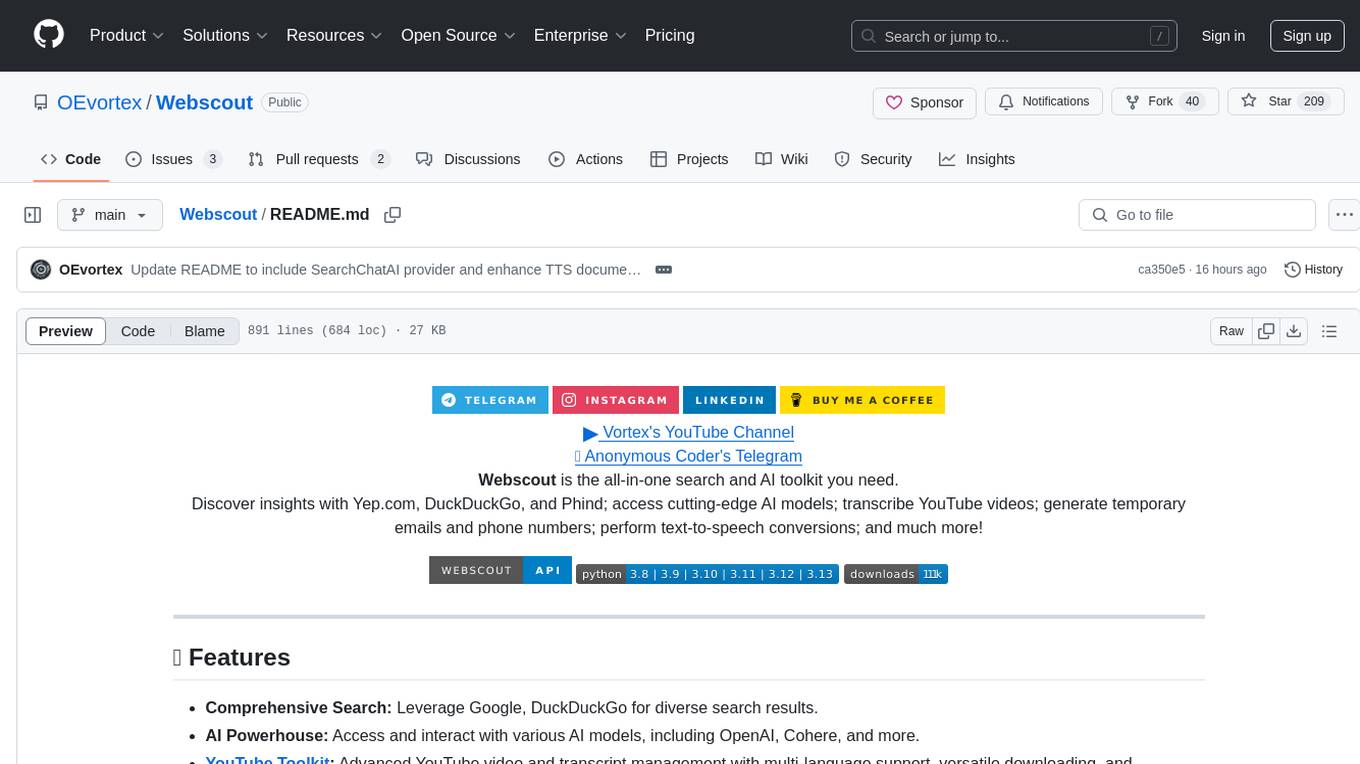
Webscout
Webscout is an all-in-one Python toolkit for web search, AI interaction, digital utilities, and more. It provides access to diverse search engines, cutting-edge AI models, temporary communication tools, media utilities, developer helpers, and powerful CLI interfaces through a unified library. With features like comprehensive search leveraging Google and DuckDuckGo, AI powerhouse for accessing various AI models, YouTube toolkit for video and transcript management, GitAPI for GitHub data extraction, Tempmail & Temp Number for privacy, Text-to-Speech conversion, GGUF conversion & quantization, SwiftCLI for CLI interfaces, LitPrinter for styled console output, LitLogger for logging, LitAgent for user agent generation, Text-to-Image generation, Scout for web parsing and crawling, Awesome Prompts for specialized tasks, Weather Toolkit, and AI Search Providers.
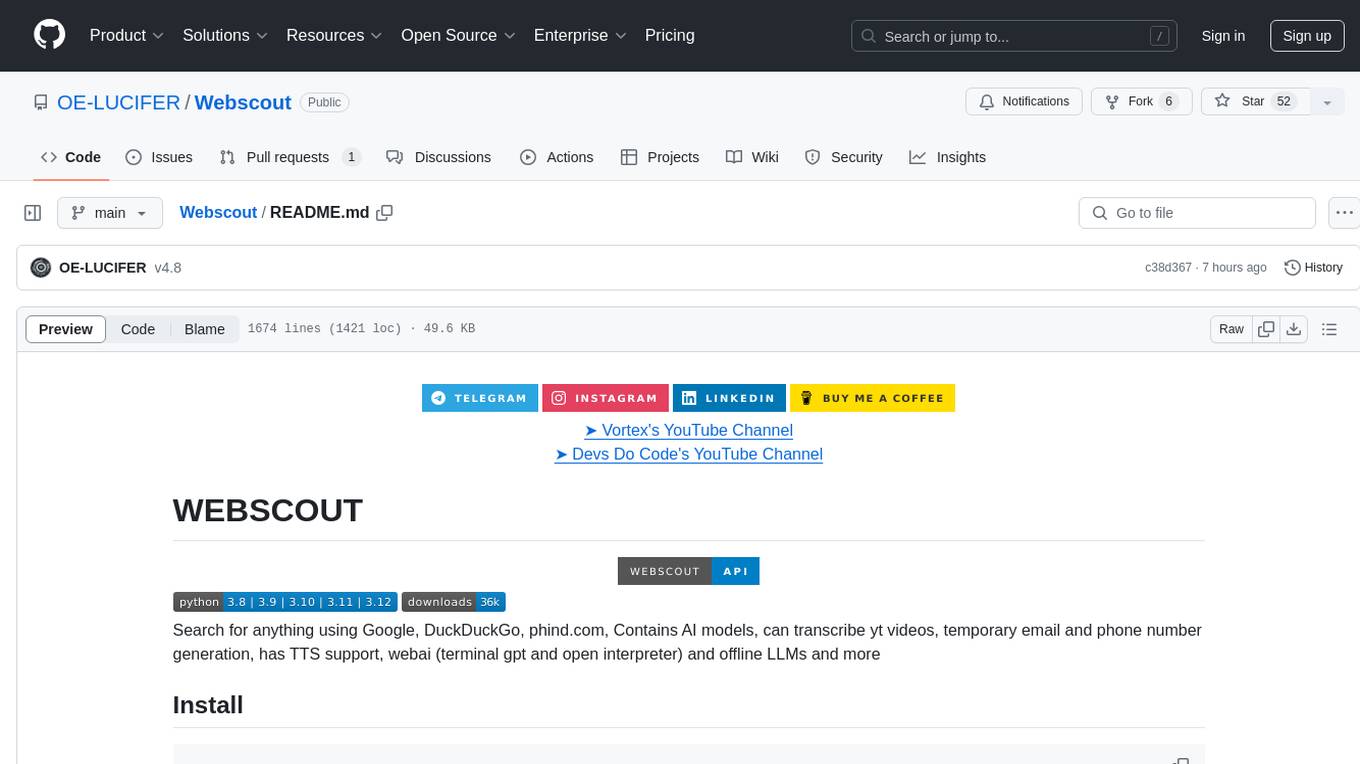
Webscout
WebScout is a versatile tool that allows users to search for anything using Google, DuckDuckGo, and phind.com. It contains AI models, can transcribe YouTube videos, generate temporary email and phone numbers, has TTS support, webai (terminal GPT and open interpreter), and offline LLMs. It also supports features like weather forecasting, YT video downloading, temp mail and number generation, text-to-speech, advanced web searches, and more.
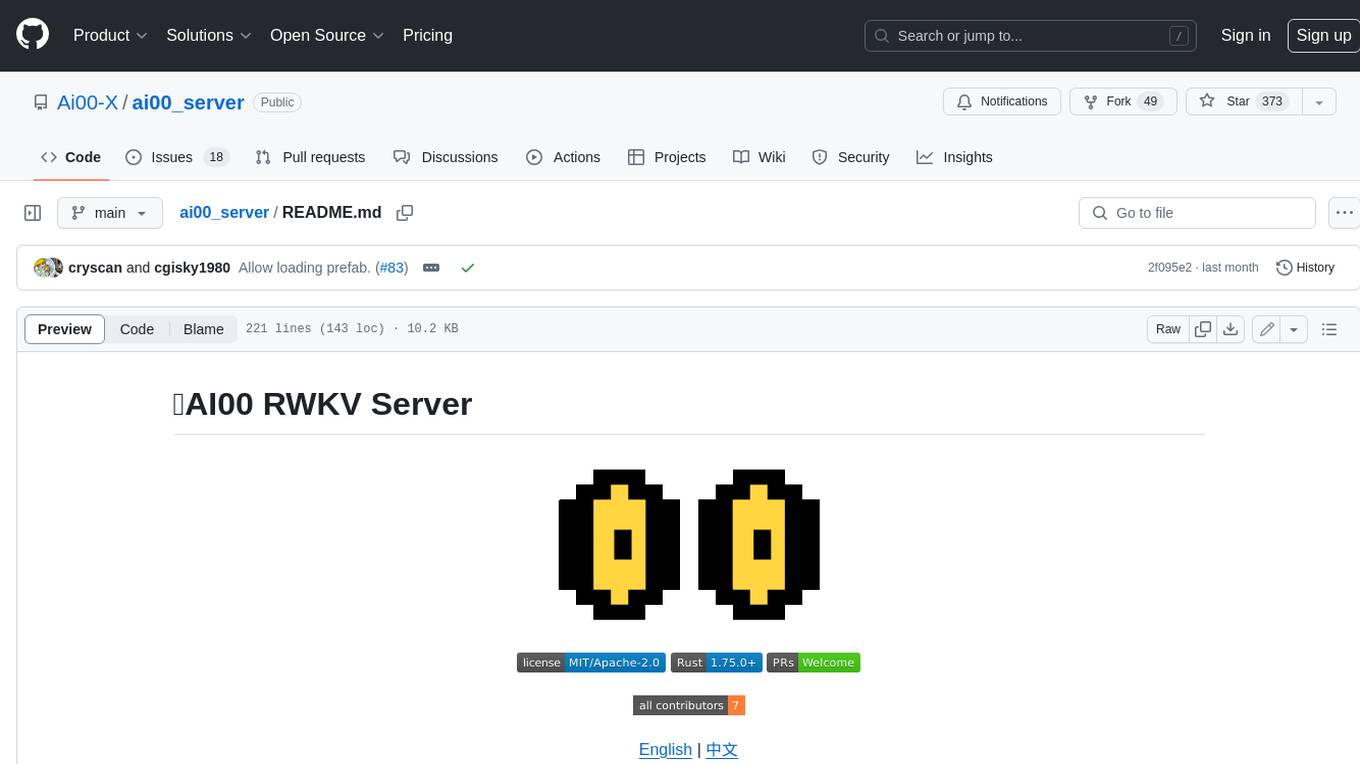
ai00_server
AI00 RWKV Server is an inference API server for the RWKV language model based upon the web-rwkv inference engine. It supports VULKAN parallel and concurrent batched inference and can run on all GPUs that support VULKAN. No need for Nvidia cards!!! AMD cards and even integrated graphics can be accelerated!!! No need for bulky pytorch, CUDA and other runtime environments, it's compact and ready to use out of the box! Compatible with OpenAI's ChatGPT API interface. 100% open source and commercially usable, under the MIT license. If you are looking for a fast, efficient, and easy-to-use LLM API server, then AI00 RWKV Server is your best choice. It can be used for various tasks, including chatbots, text generation, translation, and Q&A.
aiavatarkit
AIAvatarKit is a tool for building AI-based conversational avatars quickly. It supports various platforms like VRChat and cluster, along with real-world devices. The tool is extensible, allowing unlimited capabilities based on user needs. It requires VOICEVOX API, Google or Azure Speech Services API keys, and Python 3.10. Users can start conversations out of the box and enjoy seamless interactions with the avatars.
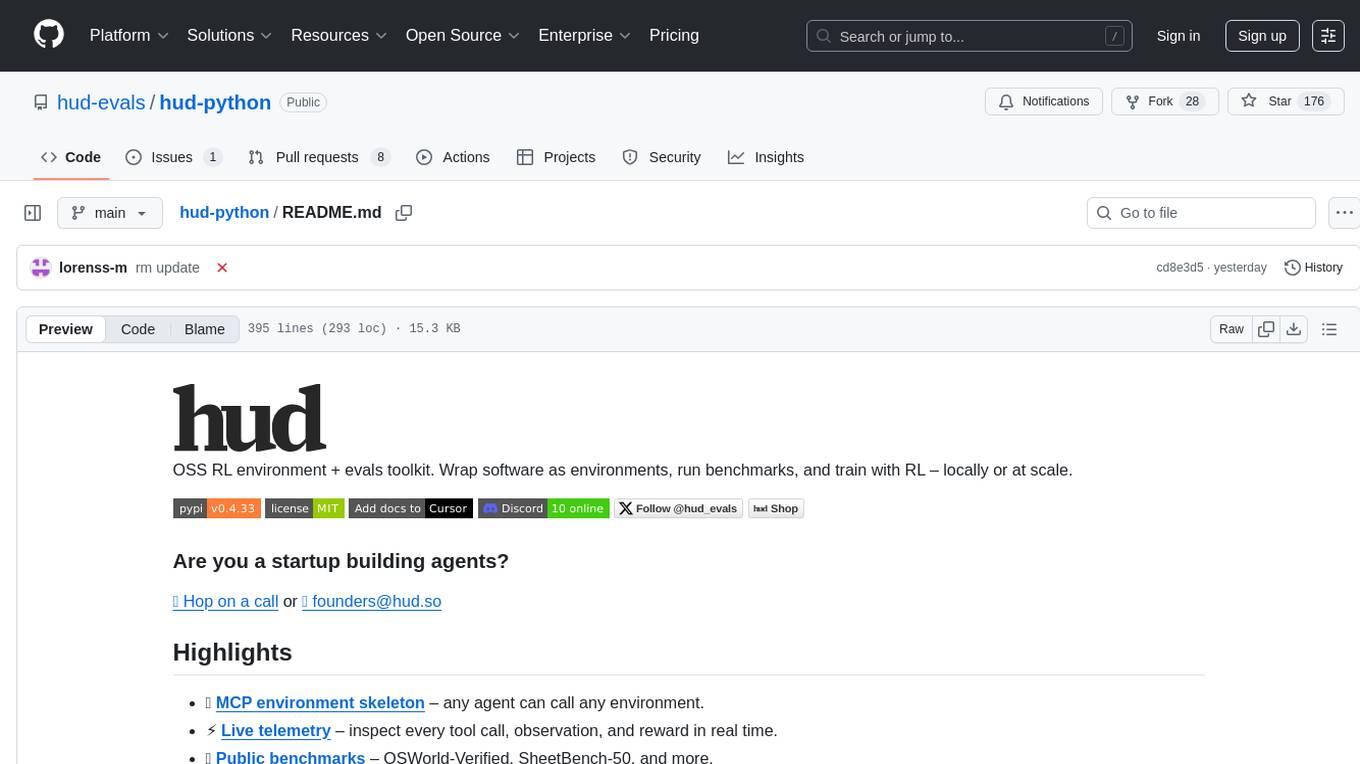
hud-python
hud-python is a Python library for creating interactive heads-up displays (HUDs) in video games. It provides a simple and flexible way to overlay information on the screen, such as player health, score, and notifications. The library is designed to be easy to use and customizable, allowing game developers to enhance the user experience by adding dynamic elements to their games. With hud-python, developers can create engaging HUDs that improve gameplay and provide important feedback to players.
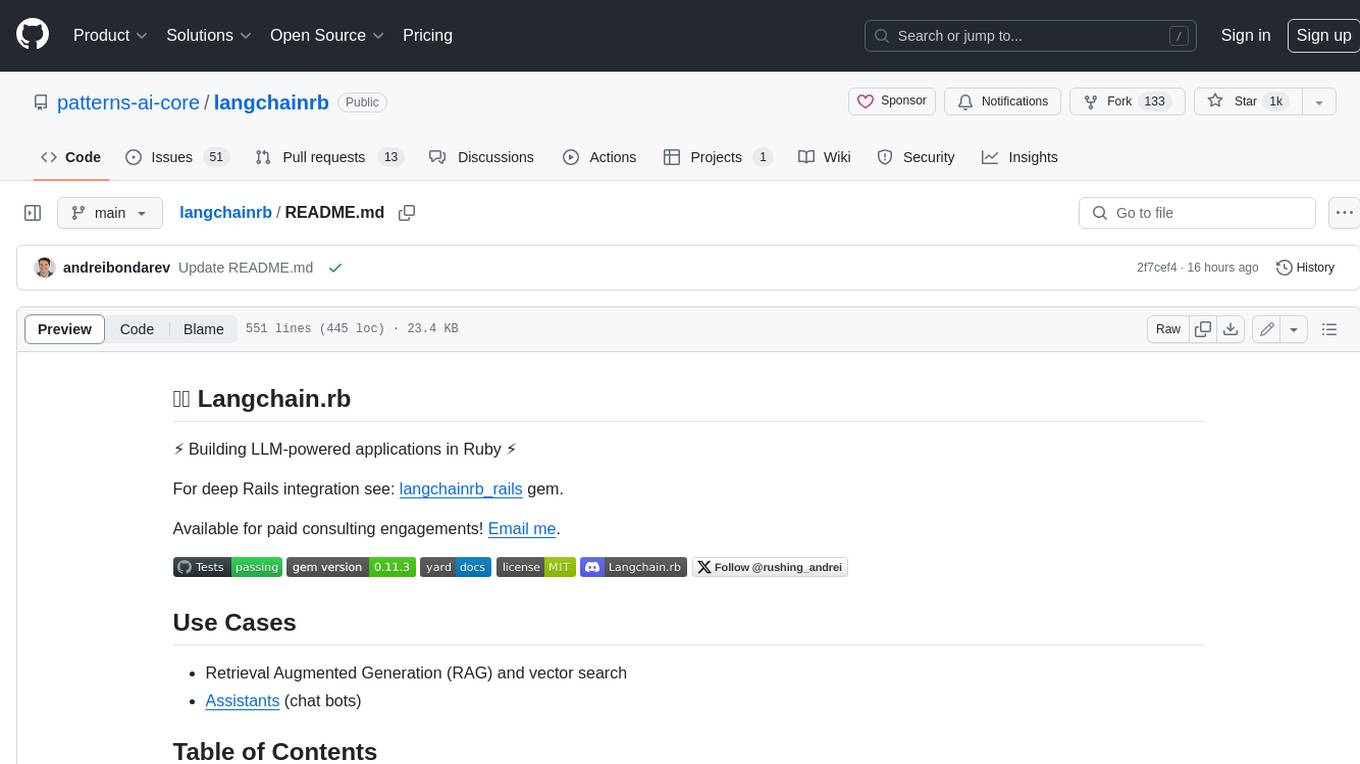
langchainrb
Langchain.rb is a Ruby library that makes it easy to build LLM-powered applications. It provides a unified interface to a variety of LLMs, vector search databases, and other tools, making it easy to build and deploy RAG (Retrieval Augmented Generation) systems and assistants. Langchain.rb is open source and available under the MIT License.
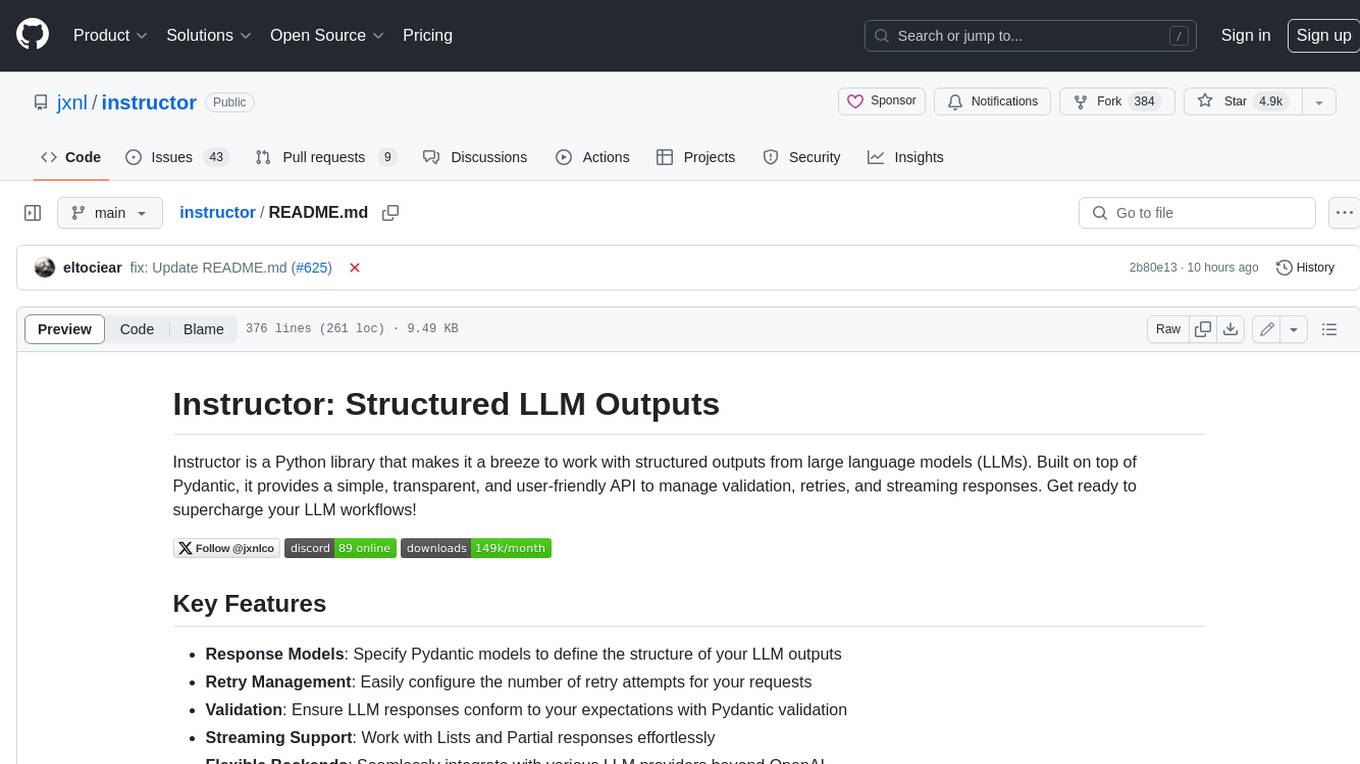
instructor
Instructor is a Python library that makes it a breeze to work with structured outputs from large language models (LLMs). Built on top of Pydantic, it provides a simple, transparent, and user-friendly API to manage validation, retries, and streaming responses. Get ready to supercharge your LLM workflows!
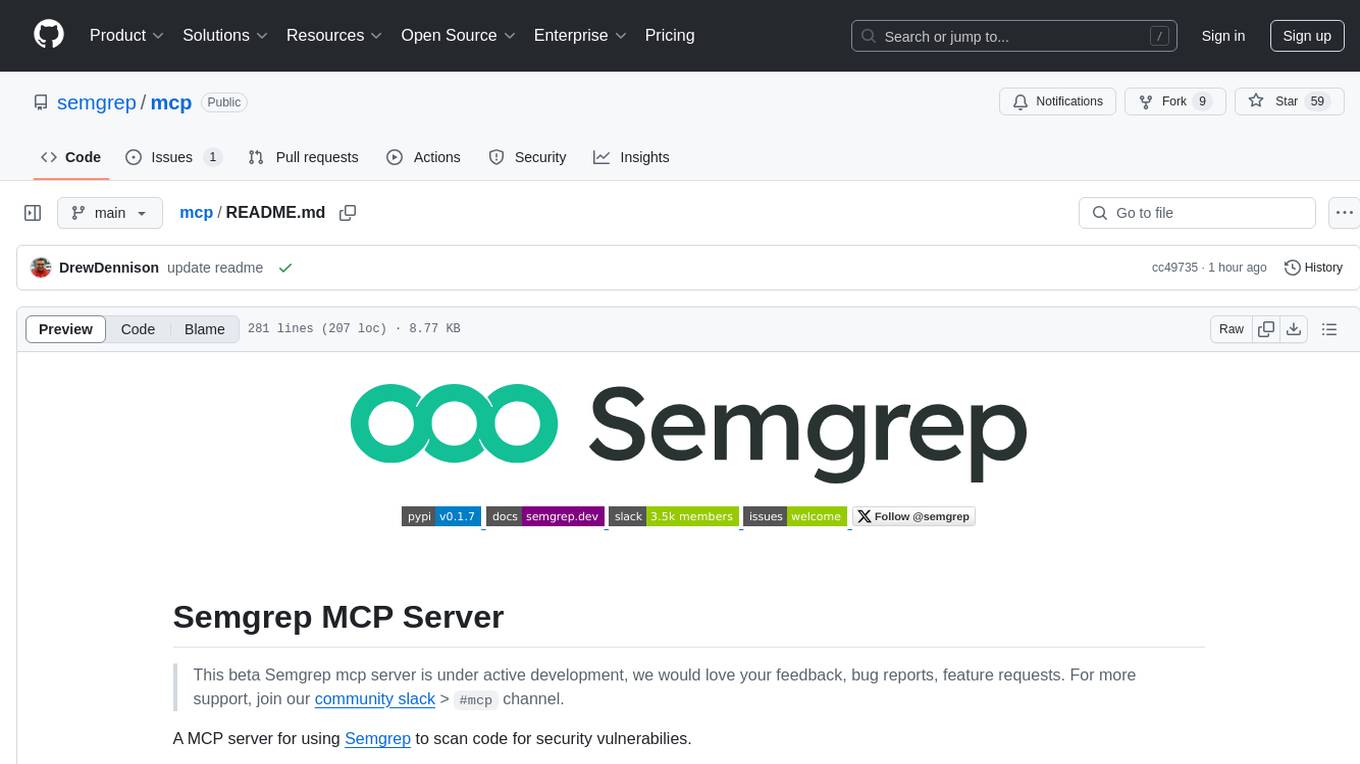
mcp
Semgrep MCP Server is a beta server under active development for using Semgrep to scan code for security vulnerabilities. It provides a Model Context Protocol (MCP) for various coding tools to get specialized help in tasks. Users can connect to Semgrep AppSec Platform, scan code for vulnerabilities, customize Semgrep rules, analyze and filter scan results, and compare results. The tool is published on PyPI as semgrep-mcp and can be installed using pip, pipx, uv, poetry, or other methods. It supports CLI and Docker environments for running the server. Integration with VS Code is also available for quick installation. The project welcomes contributions and is inspired by core technologies like Semgrep and MCP, as well as related community projects and tools.
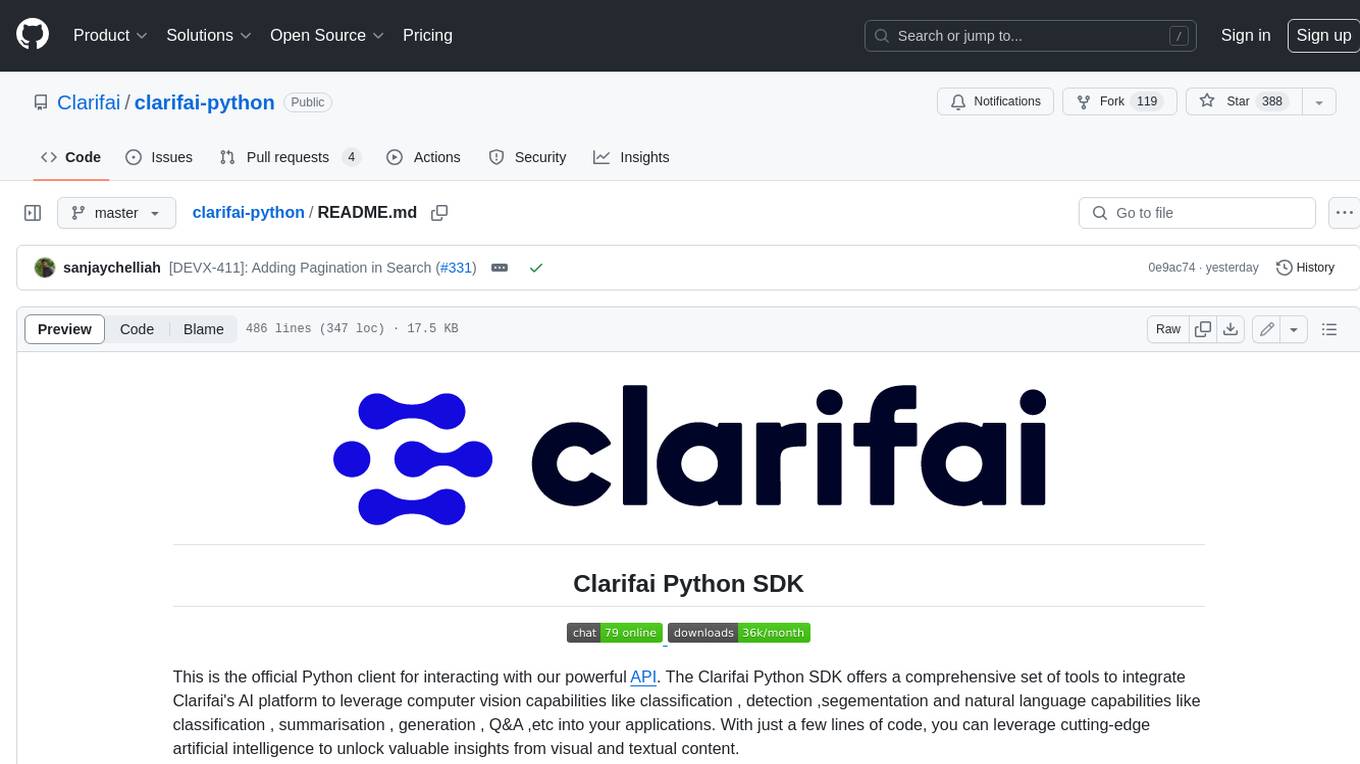
clarifai-python
The Clarifai Python SDK offers a comprehensive set of tools to integrate Clarifai's AI platform to leverage computer vision capabilities like classification , detection ,segementation and natural language capabilities like classification , summarisation , generation , Q&A ,etc into your applications. With just a few lines of code, you can leverage cutting-edge artificial intelligence to unlock valuable insights from visual and textual content.
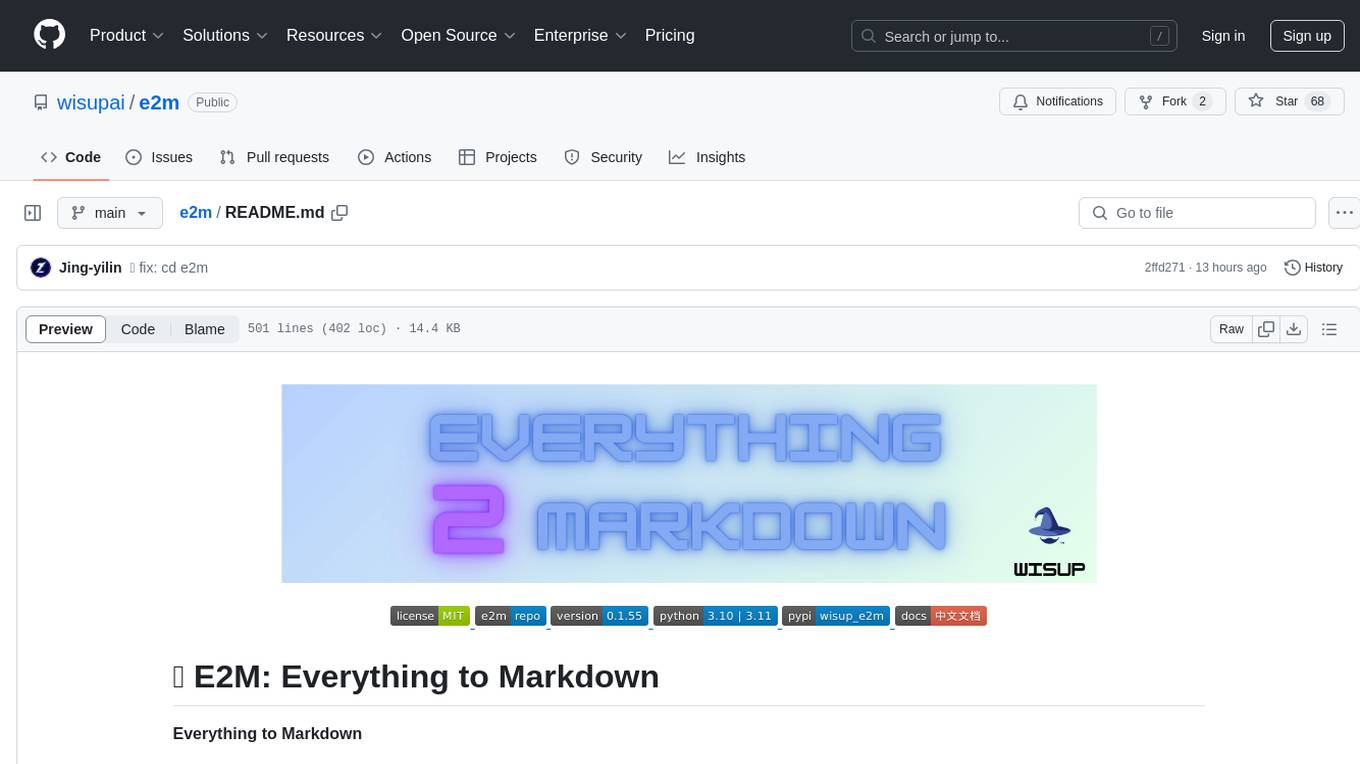
e2m
E2M is a Python library that can parse and convert various file types into Markdown format. It supports the conversion of multiple file formats, including doc, docx, epub, html, htm, url, pdf, ppt, pptx, mp3, and m4a. The ultimate goal of the E2M project is to provide high-quality data for Retrieval-Augmented Generation (RAG) and model training or fine-tuning. The core architecture consists of a Parser responsible for parsing various file types into text or image data, and a Converter responsible for converting text or image data into Markdown format.
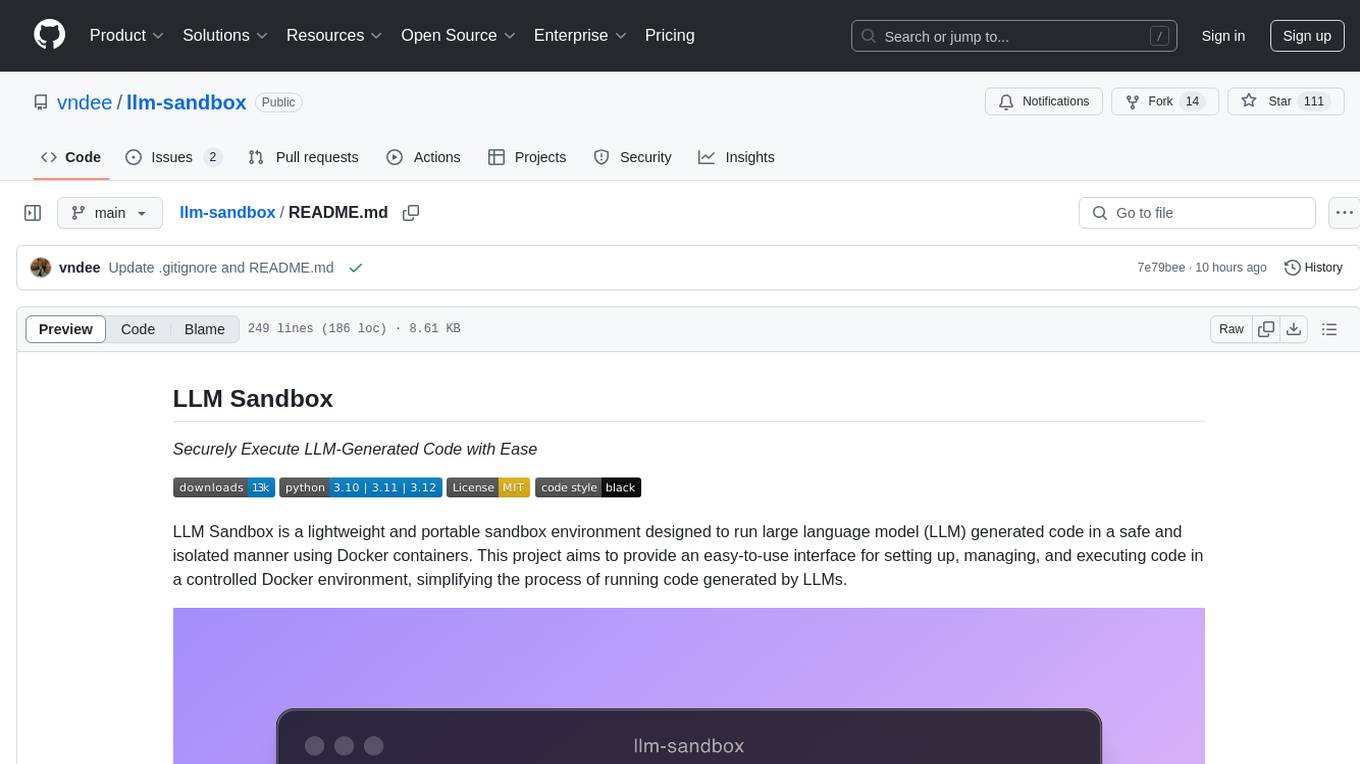
llm-sandbox
LLM Sandbox is a lightweight and portable sandbox environment designed to securely execute large language model (LLM) generated code in a safe and isolated manner using Docker containers. It provides an easy-to-use interface for setting up, managing, and executing code in a controlled Docker environment, simplifying the process of running code generated by LLMs. The tool supports multiple programming languages, offers flexibility with predefined Docker images or custom Dockerfiles, and allows scalability with support for Kubernetes and remote Docker hosts.
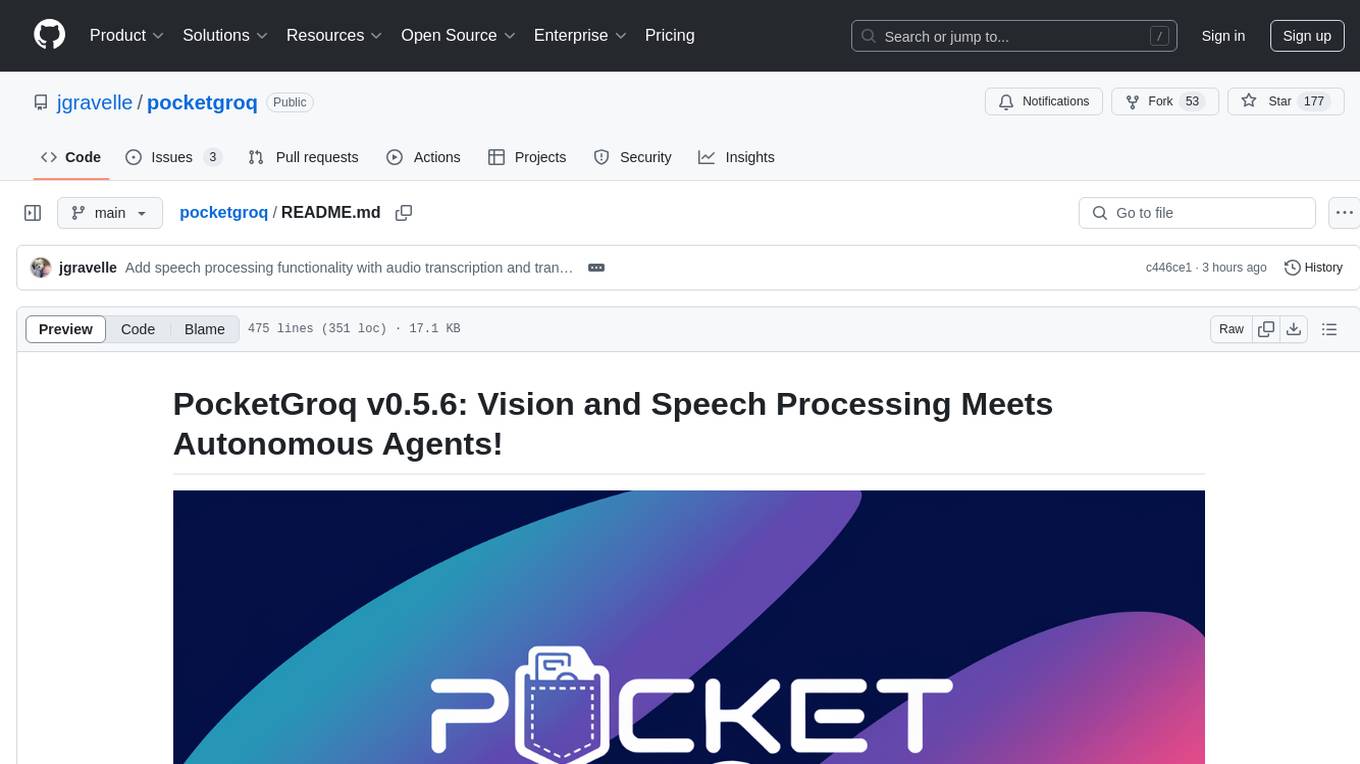
pocketgroq
PocketGroq is a tool that provides advanced functionalities for text generation, web scraping, web search, and AI response evaluation. It includes features like an Autonomous Agent for answering questions, web crawling and scraping capabilities, enhanced web search functionality, and flexible integration with Ollama server. Users can customize the agent's behavior, evaluate responses using AI, and utilize various methods for text generation, conversation management, and Chain of Thought reasoning. The tool offers comprehensive methods for different tasks, such as initializing RAG, error handling, and tool management. PocketGroq is designed to enhance development processes and enable the creation of AI-powered applications with ease.
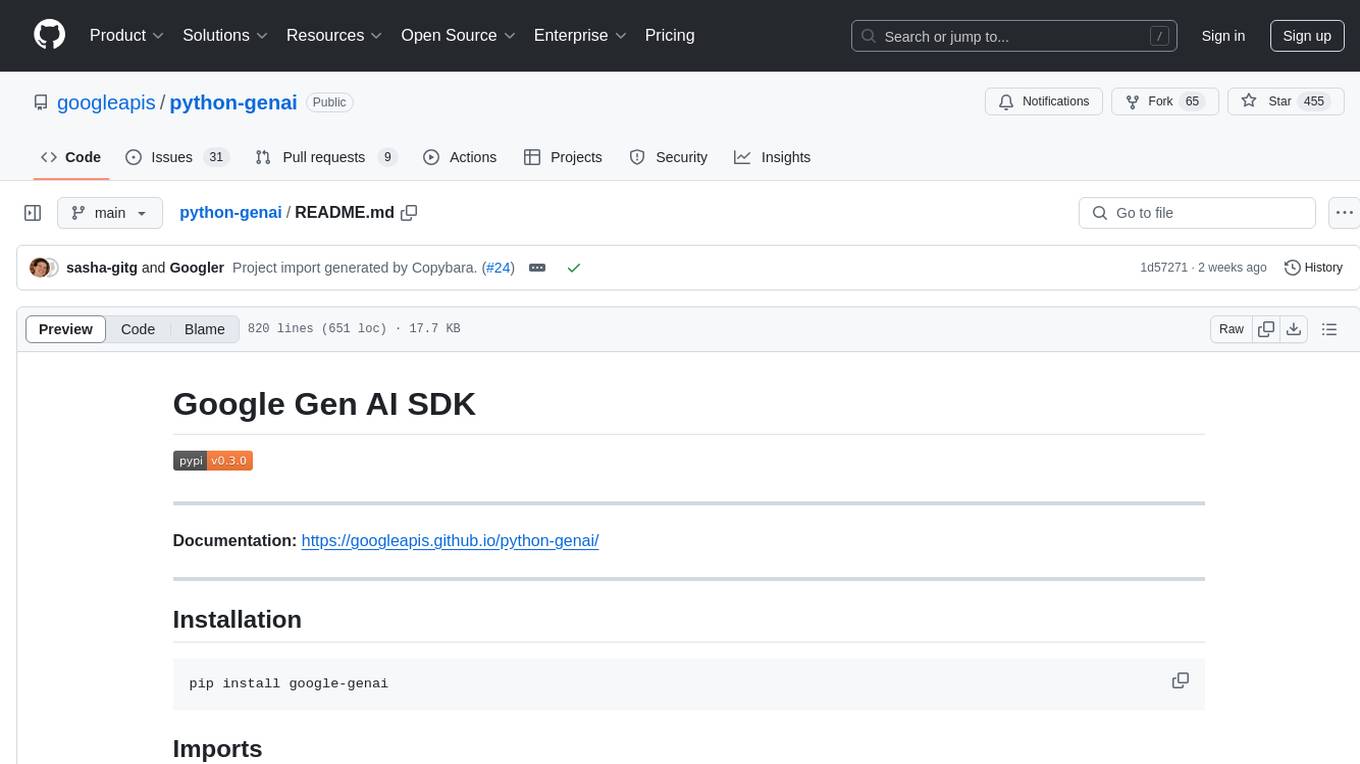
python-genai
The Google Gen AI SDK is a Python library that provides access to Google AI and Vertex AI services. It allows users to create clients for different services, work with parameter types, models, generate content, call functions, handle JSON response schemas, stream text and image content, perform async operations, count and compute tokens, embed content, generate and upscale images, edit images, work with files, create and get cached content, tune models, distill models, perform batch predictions, and more. The SDK supports various features like automatic function support, manual function declaration, JSON response schema support, streaming for text and image content, async methods, tuning job APIs, distillation, batch prediction, and more.
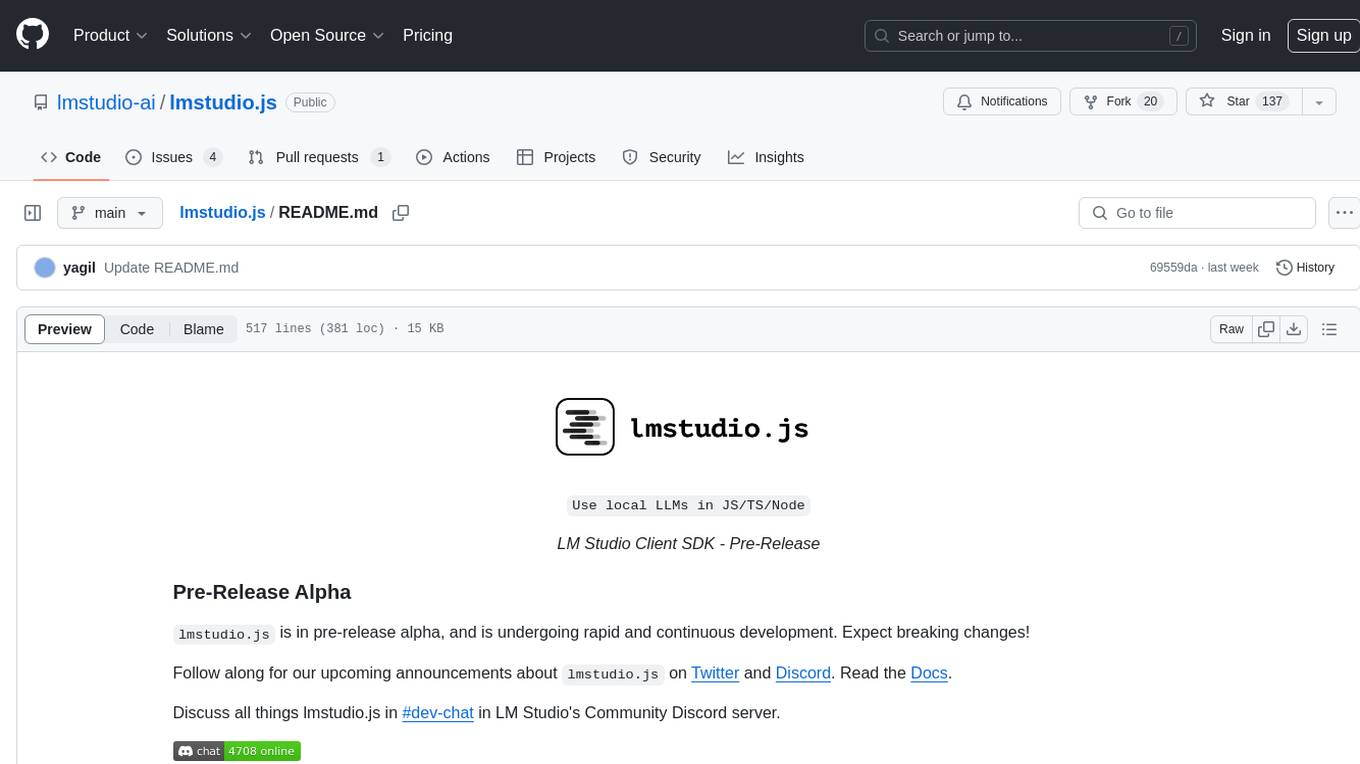
lmstudio.js
lmstudio.js is a pre-release alpha client SDK for LM Studio, allowing users to use local LLMs in JS/TS/Node. It is currently undergoing rapid development with breaking changes expected. Users can follow LM Studio's announcements on Twitter and Discord. The SDK provides API usage for loading models, predicting text, setting up the local LLM server, and more. It supports features like custom loading progress tracking, model unloading, structured output prediction, and cancellation of predictions. Users can interact with LM Studio through the CLI tool 'lms' and perform tasks like text completion, conversation, and getting prediction statistics.
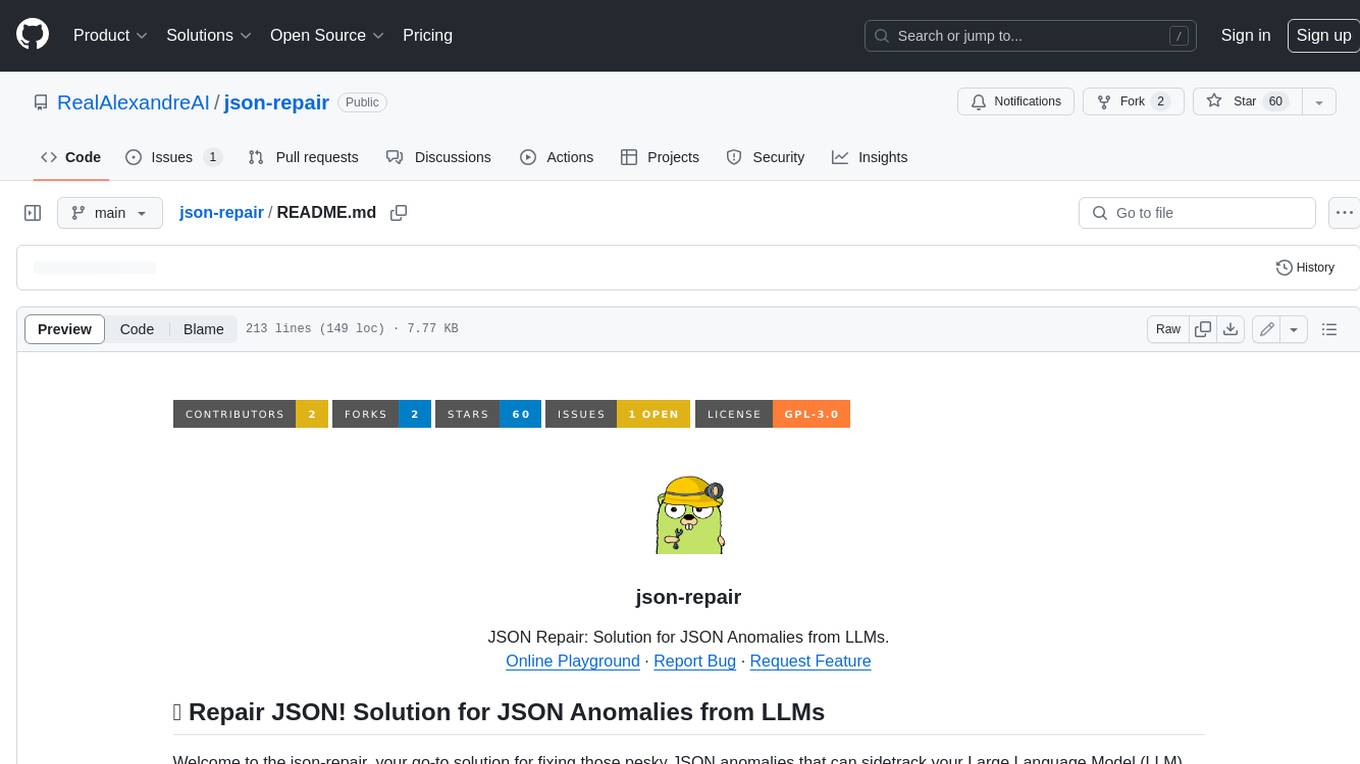
json-repair
JSON Repair is a toolkit designed to address JSON anomalies that can arise from Large Language Models (LLMs). It offers a comprehensive solution for repairing JSON strings, ensuring accuracy and reliability in your data processing. With its user-friendly interface and extensive capabilities, JSON Repair empowers developers to seamlessly integrate JSON repair into their workflows.
For similar tasks

LLMStack
LLMStack is a no-code platform for building generative AI agents, workflows, and chatbots. It allows users to connect their own data, internal tools, and GPT-powered models without any coding experience. LLMStack can be deployed to the cloud or on-premise and can be accessed via HTTP API or triggered from Slack or Discord.

ai-guide
This guide is dedicated to Large Language Models (LLMs) that you can run on your home computer. It assumes your PC is a lower-end, non-gaming setup.

onnxruntime-genai
ONNX Runtime Generative AI is a library that provides the generative AI loop for ONNX models, including inference with ONNX Runtime, logits processing, search and sampling, and KV cache management. Users can call a high level `generate()` method, or run each iteration of the model in a loop. It supports greedy/beam search and TopP, TopK sampling to generate token sequences, has built in logits processing like repetition penalties, and allows for easy custom scoring.

jupyter-ai
Jupyter AI connects generative AI with Jupyter notebooks. It provides a user-friendly and powerful way to explore generative AI models in notebooks and improve your productivity in JupyterLab and the Jupyter Notebook. Specifically, Jupyter AI offers: * An `%%ai` magic that turns the Jupyter notebook into a reproducible generative AI playground. This works anywhere the IPython kernel runs (JupyterLab, Jupyter Notebook, Google Colab, Kaggle, VSCode, etc.). * A native chat UI in JupyterLab that enables you to work with generative AI as a conversational assistant. * Support for a wide range of generative model providers, including AI21, Anthropic, AWS, Cohere, Gemini, Hugging Face, NVIDIA, and OpenAI. * Local model support through GPT4All, enabling use of generative AI models on consumer grade machines with ease and privacy.

khoj
Khoj is an open-source, personal AI assistant that extends your capabilities by creating always-available AI agents. You can share your notes and documents to extend your digital brain, and your AI agents have access to the internet, allowing you to incorporate real-time information. Khoj is accessible on Desktop, Emacs, Obsidian, Web, and Whatsapp, and you can share PDF, markdown, org-mode, notion files, and GitHub repositories. You'll get fast, accurate semantic search on top of your docs, and your agents can create deeply personal images and understand your speech. Khoj is self-hostable and always will be.

langchain_dart
LangChain.dart is a Dart port of the popular LangChain Python framework created by Harrison Chase. LangChain provides a set of ready-to-use components for working with language models and a standard interface for chaining them together to formulate more advanced use cases (e.g. chatbots, Q&A with RAG, agents, summarization, extraction, etc.). The components can be grouped into a few core modules: * **Model I/O:** LangChain offers a unified API for interacting with various LLM providers (e.g. OpenAI, Google, Mistral, Ollama, etc.), allowing developers to switch between them with ease. Additionally, it provides tools for managing model inputs (prompt templates and example selectors) and parsing the resulting model outputs (output parsers). * **Retrieval:** assists in loading user data (via document loaders), transforming it (with text splitters), extracting its meaning (using embedding models), storing (in vector stores) and retrieving it (through retrievers) so that it can be used to ground the model's responses (i.e. Retrieval-Augmented Generation or RAG). * **Agents:** "bots" that leverage LLMs to make informed decisions about which available tools (such as web search, calculators, database lookup, etc.) to use to accomplish the designated task. The different components can be composed together using the LangChain Expression Language (LCEL).

danswer
Danswer is an open-source Gen-AI Chat and Unified Search tool that connects to your company's docs, apps, and people. It provides a Chat interface and plugs into any LLM of your choice. Danswer can be deployed anywhere and for any scale - on a laptop, on-premise, or to cloud. Since you own the deployment, your user data and chats are fully in your own control. Danswer is MIT licensed and designed to be modular and easily extensible. The system also comes fully ready for production usage with user authentication, role management (admin/basic users), chat persistence, and a UI for configuring Personas (AI Assistants) and their Prompts. Danswer also serves as a Unified Search across all common workplace tools such as Slack, Google Drive, Confluence, etc. By combining LLMs and team specific knowledge, Danswer becomes a subject matter expert for the team. Imagine ChatGPT if it had access to your team's unique knowledge! It enables questions such as "A customer wants feature X, is this already supported?" or "Where's the pull request for feature Y?"

infinity
Infinity is an AI-native database designed for LLM applications, providing incredibly fast full-text and vector search capabilities. It supports a wide range of data types, including vectors, full-text, and structured data, and offers a fused search feature that combines multiple embeddings and full text. Infinity is easy to use, with an intuitive Python API and a single-binary architecture that simplifies deployment. It achieves high performance, with 0.1 milliseconds query latency on million-scale vector datasets and up to 15K QPS.

